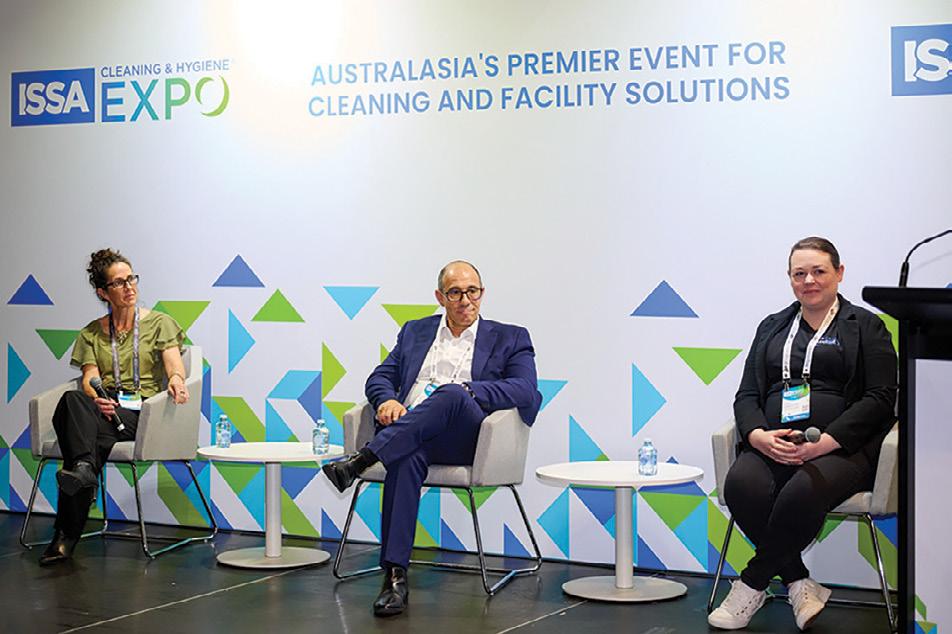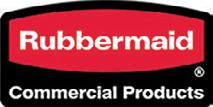




Cordless innovation is more than just bigger batteries. It’s about creating battery technology and motor engineering that work together for optimum performance. With Makita’s XGT 40V Max platform, the higher battery output is a genuine solution for high demand cleaning and maintenance applications. Makita’s XGT tools and batteries have been designed with innovative smart technology, delivering reliable tools that are a must for all professional applications.
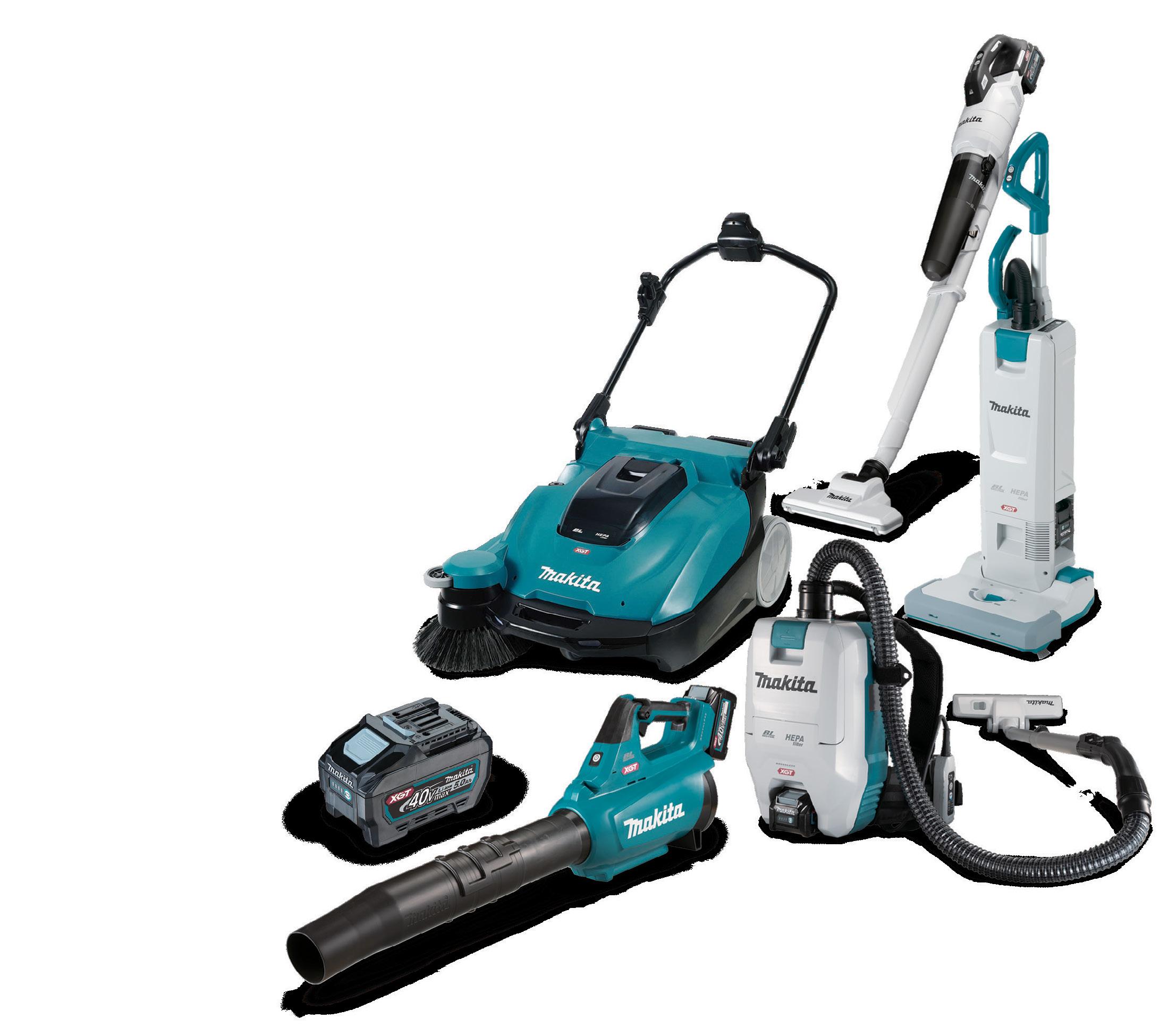

Telescopic pipe to suit various operators

• Constant speed control maintains efficiency under heavy load
• Reverse function for hands free brush removal
• 48 minutes of continuous operation with BL4040 (Mode 3)

3 Speed settings for various applications
low profile head

INCLEAN is published by
Niche Media Pty Ltd on behalf of ISSA – The Worldwide Cleaning Industry Association.
Ground Floor, 15 Paran Place, Glen Iris VIC 3146 Australia
MANAGING DIRECTOR, GROUP PUBLISHER
Paul Lidgerwood
EDITOR
Tim McDonald
GENERAL MANAGER COMMERCIAL
Jillian Hood
MEDIA SALES AND PARTNERSHIPS EXECUTIVE
Shloka Yewale
PRODUCTION MANAGER
Alvin Wu
EDITORIAL DESIGNER
Norsham Husaini
Print Post Approved Publication No. PP: 255003/09765
To subscribe, email info@incleanmag.com.au

AINCLEAN is owned by ISSA
ABN: 44 617 407 020
P: +61 2 9890 4951
A: Suite 1, Level 1, 52 O’Connell Street, Parramatta, NSW, 2150 W: www.issa.com
DISCLAIMER: This publication is published by Niche Media PTY LTD. Materials in this publication have been created by a variety of different entities and, to the extent permitted by law, the Publisher accepts no liability for materials created by others. All materials should be considered protected by Australian and international intellectual property laws. Unless you are authorised by law or the copyright owner to do so, you may not copy any of the materials. The mention of a product or service, person or company in this publication does not indicate Publisher endorsement. The views expressed in this publication do not necessarily represent the opinion of the Publisher, its agents, company officers or employees. Any use of the information contained in this publication is at the sole risk of the person using that information. The user should make independent enquiries as to the accuracy of the information before relying on that information. All express or implied terms, conditions, warranties, statements, assurances and representations in relation to the Publisher, its publications and its services are expressly excluded save for those conditions and warranties which must be implied under the laws of any State of Australia or the provisions of Division 2 of Part V of the Trade Practices Act 1974 and any statutory modification or re-enactment thereof. To the extent permitted by law, the Publisher will not be liable for any damages including special, exemplary, punitive or consequential damages (including but not limited to economic loss or loss of profit or revenue or loss of opportunity) or indirect loss or damage of any kind arising in contract, tort or otherwise, even if advised of the possibility of such loss of profits or damages. While we use our best endeavours to ensure accuracy of the materials we create, to the extent permitted by law, the Publisher excludes all liability for loss resulting from any inaccuracies or false or misleading statements that may appear in this publication. Copyright © 2025 - ISSA.
s the cleaning and hygiene industry across Oceania continues to evolve, so too does the depth and diversity of the stories we tell. This winter edition of INCLEAN brings you closer to the people, challenges and innovations reshaping our sector in ways that are bold and incredibly inspiring.
Our cover story, ‘Cleaning on Country’, celebrates First Nations-owned cleaning businesses across Australia and New Zealand. These enterprises are anchoring cultural identity while building community wealth and creating long-term pathways for Indigenous employment. It’s a powerful reminder that inclusive procurement is a chance to support real change.
We also tackle a growing issue behind the scenes in ‘Risky business: Cleaning companies under pressure’. With liability and workers’ compensation costs climbing fast, many operators are being forced to rethink their risk strategies. This investigative feature breaks down what’s driving the surge and how business owners can protect themselves in an increasingly volatile insurance market.
While the industry continues to push forward, it’s important we don’t lose sight of the human element. In ‘Mind the gap: Cleaning up workplace wellbeing’, we explore the hidden psychological toll of shift work, isolation and job insecurity, issues too often overlooked in an essential workforce. Backed by new data and powerful first-person accounts, this piece makes a clear case for embedding mental wellbeing into the very fabric of the sector.
Also inside, we cut through the marketing noise in ‘AI, IoT and automation: Decoding the hype in cleaning tech’, where we assess the reality of emerging technologies beyond the buzzwords. What’s working, what’s not and where the smart investments are being made. You’ll find it all here.
As always, thank you for being part of the INCLEAN community. This issue is a testament to the strength and momentum of our industry and the people who keep it moving forward.
Enjoy the read,
Tim McDonald

Niche Media takes its corporate and social responsibilities seriously and is committed to reducing its impact on the environment. We continuously strive to improve our environmental performance and to initiate additional CSR-based projects and activities. As part of our company policy we ensure that the products and services used in the manufacture of this magazine are sourced from environmentally responsible suppliers. This magazine has been printed on paper produced from sustainably sourced wood and pulp fibre and is accredited under PEFC chain of custody.
PEFC certified wood and paper products come from environmentally appropriate, socially beneficial and economically viable management of forests.
From high-traffic floors to sparkling restrooms, Agar delivers cleaning solutions that work as hard as you do. Trusted by professionals across Australia, our range of high-performance chemicals, disinfectants, and floor care products are designed to meet the toughest hygiene standards in commercial, healthcare, hospitality, and industrial settings.
Backed by expert support and over 55 years of experience, Agar is your reliable partner in achieving spotless results, every time. Clean smarter. Clean safer. Clean with Agar.
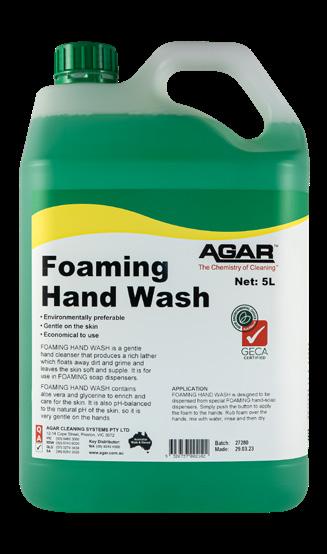

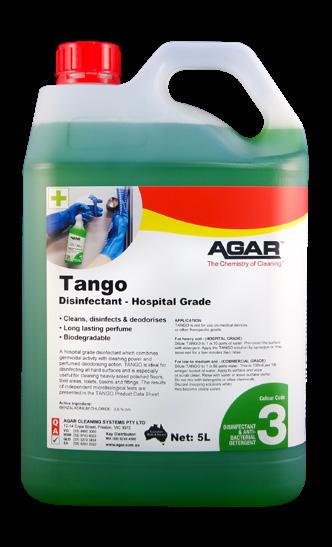
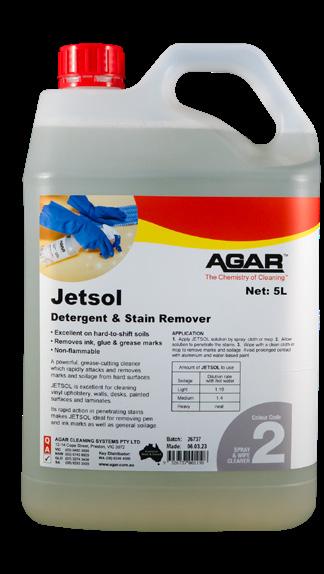


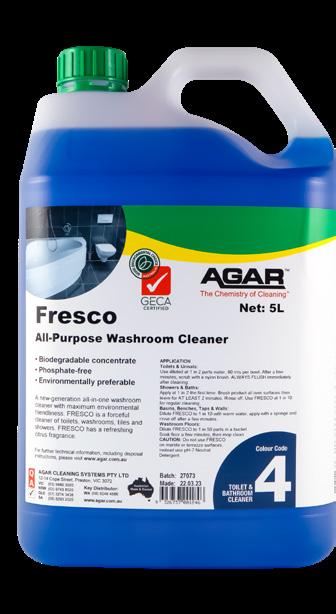



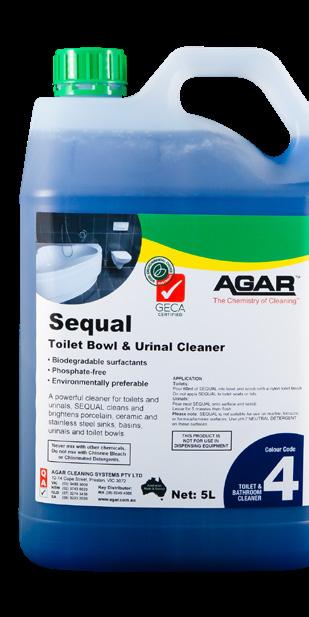
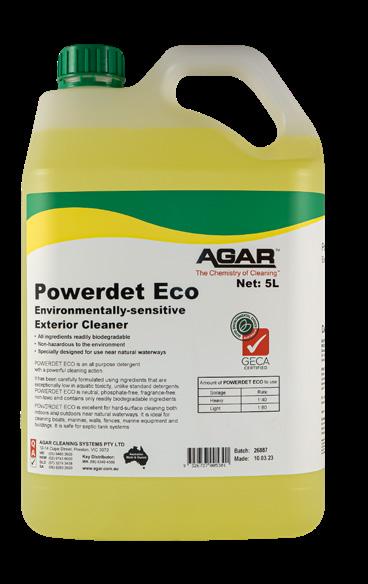


















Estimating & Bidding Made Easy Online Training Course
Wednesday, 17 September 2025, 9:30am - 1:30pm AEST
This half-day virtual course looks at all the defined systems of costing for contracts, organisational structures and disciplines. events.issa.com/asia-oceania-events/

ISSA Cleaning & Hygiene Expo
29-30 October 2025
Australasia’s premier event for cleaning and facility solutions held at ICC Sydney. cleaninghygieneexpo.issa.com

ISSA Show North America
10-13 November 2025
The premier trade show exclusively for the cleaning and facility management industry returns to Las Vegas. issashow.com
Accredited Auditing Professional (AAP) Online Training Course
Wednesday, 26 November and Thursday 27 November 2025, 10am - 1pm AEDT
A two-day course is designed for industry professionals looking to enhance their knowledge and skills around quality assurance and building audits. events.issa.com/asia-oceania-events/


incleanmag.com.au
Whiteley opens pioneering therapeutics plant in NSW
Australian manufacturer Whiteley officially opened a first-of-its-kind Human Therapeutics Plant in New South Wales – a major milestone for the nation’s healthcare manufacturing sector.
It all happened at the Restoration Industry Association conference and Trade Show
On Gold Coast, some of the sharpest minds and busiest hands in the restoration industry gathered for two full days of learning, connection and critical conversation.
Fair Work Commission announced a 3.5 percent wage increase
The national minimum wage saw an increase effective from 1 July 2025. The wage hike directly impacts approximately 2.6 million low-wage workers, including those in the cleaning industry
ON THE COVER
ISSA ran their Accredited Auditing Professional course on 18 June. Delivered by Lorraine Rogic, the one-day course educated industry professionals looking to enhance their knowledge and skills around quality assurance and building audits.
Clean, kill, protect: Hygiene tactics for modern facilities
Antimicrobial technologies are transforming how facilities maintain cleanliness, offering a proactive approach to inhibiting the growth of harmful microorganisms.
maintenance starts at the kerb, not the door
From cracked pavement to faded striping, the exterior of a commercial property plays a decisive role in perception, safety and functionality.
RapidClean is an Australian and New Zealand cooperative with over 70 stores, employing more than 500 dedicated professionals with 150 delivery vehicles on the road. The RapidClean business is made up of cleaning supply experts who manage their own stores and offer customers the support of a national organisation, combined with a local touch and cost-effective, one-stop-shop solutions.

12 Cleaning on Country Indigenous-led cleaning and hygiene businesses are reshaping what it means to operate with purpose in Australia.
19 Cleaning companies under pressure
From public liability to workers’ compensation, the cost of cover is climbing fast, creating serious financial strain for businesses in the sector.
26 Shaping the Future of Cleaning
The annual ISSA Cleaning and Hygiene Expo returns to Sydney in 2025.
28 Greener gears
As demands rise for low-impact operations, cleaning equipment is undergoing a quiet, methodical transformation rooted in robust engineering.
31 Mind the gap
Mental wellbeing for those working outside the nine-to-five is often overlooked, and it's time for a change.
34 Decoding the hype
New tech is changing cleaning. Discover what companies must get right.

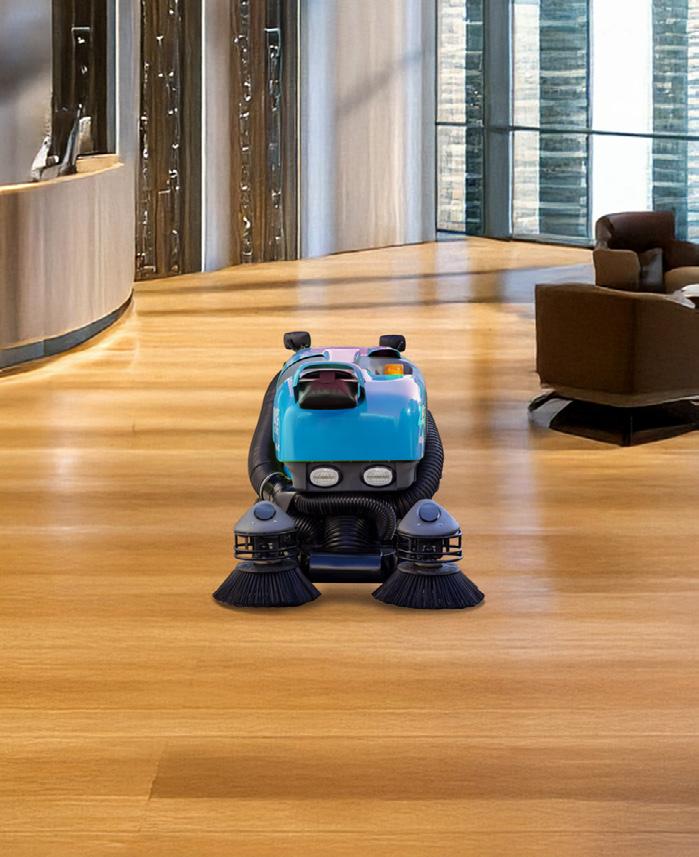
37 Mastering chemical handling
The cleaning industry is raising the bar with smarter systems, stronger compliance and a commitment to low-impact solutions that prioritise people and the planet.
40 RIA Rewind: Innovations, insights and industry shifts
The 2025 RIA Restoration Conference and Trade Show brought together the sharpest minds and busiest hands in the restoration industry
42 The business of responsibility As priorities shift, ESG frameworks help businesses improve operations, strengthen governance and embrace sustainable practices.


The ACCC will not oppose Cleanaway Waste Management Limited’s (ASX:CWY) proposed acquisition of Contract Resources Group Pty Ltd.
Cleanaway and Contract Resources both supply a range of industrial services in Australia, including maintenance and cleaning of industrial facilities and equipment.
Cleanaway is also one of the largest waste management companies in Australia.
The ACCC’s review considered the likely effect of the proposed acquisition on competition for the provision of industrial services.
The review found Contract Resources primarily provides specialist industrial services, such as catalyst handling, which Cleanaway does not supply.
“Cleanaway and Contract Resources compete mainly for customers in the oil and gas sector. These customers are generally large, well-resourced organisations that could sponsor new entry or sponsor the expansion of existing rival suppliers” ACCC Commissioner Dr Philip Williams said.
“We have seen oil and gas companies sponsor new entry before”.
The ACCC’s review also considered the likely effect of the acquisition on competition in the supply of waste management services.
The review focused on whether the merged entity would be able to profitably leverage Contract Resources’ strong position in the supply of specialist industrial services into Cleanaway’s waste management offering, for example, by requiring customers to acquire their waste management services as a condition of supplying specialist industrial services.
The ACCC found that this is unlikely to be a profitable strategy because customers have other options to source these specialist industrial services.
“Overall, we did not find that the proposed acquisition is likely to substantially lessen competition in the supply of industrial services or waste management services,” Dr Williams said. ■
More information can be found on the ACCC’s public register: accc.gov.au

Australian manufacturer Whiteley has officially opened a first-of-its-kind Human Therapeutics Plant in Tomago, New South Wales, marking a major milestone for the Hunter Region and the nation’s healthcare manufacturing sector.
The $25 million purpose-built facility will produce alcohol-based hand rubs and overthe-counter medicines for hospitals across Australia and New Zealand. It is designed to Good Manufacturing Practice (GMP) standards and is the only therapeutic plant in NSW to meet modern fire safety and engineering compliance benchmarks.
Opened by Whiteley executive chairman Dr Greg Whiteley and NSW Member for Port Stephens, the Hon. Kate Washington MP, the plant is expected to create 30 new jobs across research, manufacturing, compliance and operations.
“This facility is a long-term investment in Australian science, Australian jobs and Australian manufacturing,” Dr Whiteley said. “It levels the playing field in a sector long dominated by multinationals and puts the Hunter Region at the centre of therapeutic manufacturing in Australia.”
Whiteley is Australia’s largest manufacturer of hospital-grade disinfectants and infection prevention
products. Operating in Tomago since 1995, the family-owned business now exports to more than 35 countries and employs over 70 staff across Australia and New Zealand. In 2024, the company won NSW Business of the Year, Hunter Business of the Year, and the Excellence in International Business Award.
The new facility follows Whiteley’s recent achievement of MDSAP certification, enabling the export of medical devices from Tomago to the US and Canada. It will also support collaborative research with leading universities, including the University of Newcastle, the University of Sydney and Western Sydney University, with a focus on antimicrobial resistance and biofilm-related infections.
NSW MP Kate Washington praised the expansion, calling Whiteley “an award-winning local manufacturer that strengthened Port Stephens’ position as a manufacturing powerhouse”.
With a 50-year design life, no on-site discharge and advanced containment systems, the new plant also reflects Whiteley’s long-term environmental commitment. “We’re proud to be turning Australian research into real-world therapeutic products made in the Hunter to serve the healthcare system long into the future,” Dr Whiteley said. ■
The Restoration Industry Association (RIA) has launched its 2025 Cost of Doing Business (CODB) Survey, calling on restoration professionals to contribute to a vital industry-wide benchmarking initiative.
Now in its second year, the CODB Survey offers restoration companies the opportunity to anonymously share key financial and operational data, building a clearer picture of what it really costs to run a business in this sector. The data collected will inform industry advocacy and support long-term growth strategies.
The RIA is again partnering with KnowHow, an AI-powered operations platform designed to streamline training, onboarding and standard operating procedures. The 2025 survey follows the strong response to last year’s inaugural report, which was downloaded nearly 1000 times and widely recognised as a landmark moment for data-driven insight in the restoration space.
According to RIA CEO Kristy Cohen, the response confirmed what many already suspected: restoration businesses are hungry for real numbers and practical benchmarks.
“This second survey isn’t just about continuity, it’s about lifting the standard,” Cohen said in a statement. “Restorers want trustworthy data to inform their decisions, and we’re proud to be building a resource that empowers them to do exactly that.”
KnowHow CEO Leighton Healey agreed, describing the CODB initiative as a tool
that can sharpen decision-making and operational focus.
“Teams do their best work when they have access to the right information,” Healey stated. “This year’s report will help operators across the sector fine-tune their systems and strengthen long-term financial sustainability.”
The survey results will also feed into the RIA’s ongoing advocacy work, informing dialogue with insurers, policymakers and industry stakeholders. For an industry facing rising costs and changing expectations, the 2025 report is designed to offer clarity, credibility and confidence.
Restoration companies of all sizes –from independent operators to multi-site businesses – are encouraged to take part.
The final report will be released in October 2025. ■
To learn more or take the survey, visit restorationindustry.org

OCS Australia and New Zealand has released its 2024 ESG Report, showcasing how the business is embedding sustainability, ethical governance and social inclusion across every level of operations.
Now in its seventh year, the report reflects the progress made across OCS Australia, OCS New Zealand, Midcity and 1M, with a focus on delivering measurable outcomes for both the business and its customers.
Key results include:
• A 13 percent reduction in gross emissions across the ANZ region (compared to 2023).
• Baseline emissions reductions of 17 percent in Australia and 36 percent in New Zealand.
• Baseline Scope 3 reductions with 57 percent drop in Scope 3 emissions in Australia and 83 percent in New Zealand.
• Toitū Net Carbon Zero certification maintained across all reporting entities, including Midcity Group and 1M.
The report also celebrates social achievements, including 58 Workbridge placements for disabled jobseekers in New Zealand, 11 apprenticeships at 1M and more than 450 colleagues recognised through the TRUE Stars reward program.
Midcity continued to demonstrate its commitment to community with donations, local partnerships and operational transparency, while the ANZ business gained ISO 27001 certification for information security, reinforcing its governance credentials.
“This year’s report shows the strength of our people and the value of partnerships,” OCS ANZ managing director Gareth Marriott says.
“We’re seeing real progress because ESG is not a separate initiative, it’s embedded in how we operate.” ■
Read the full 2024 ESG Report here: ocs.com/nz/2024-esg-report/

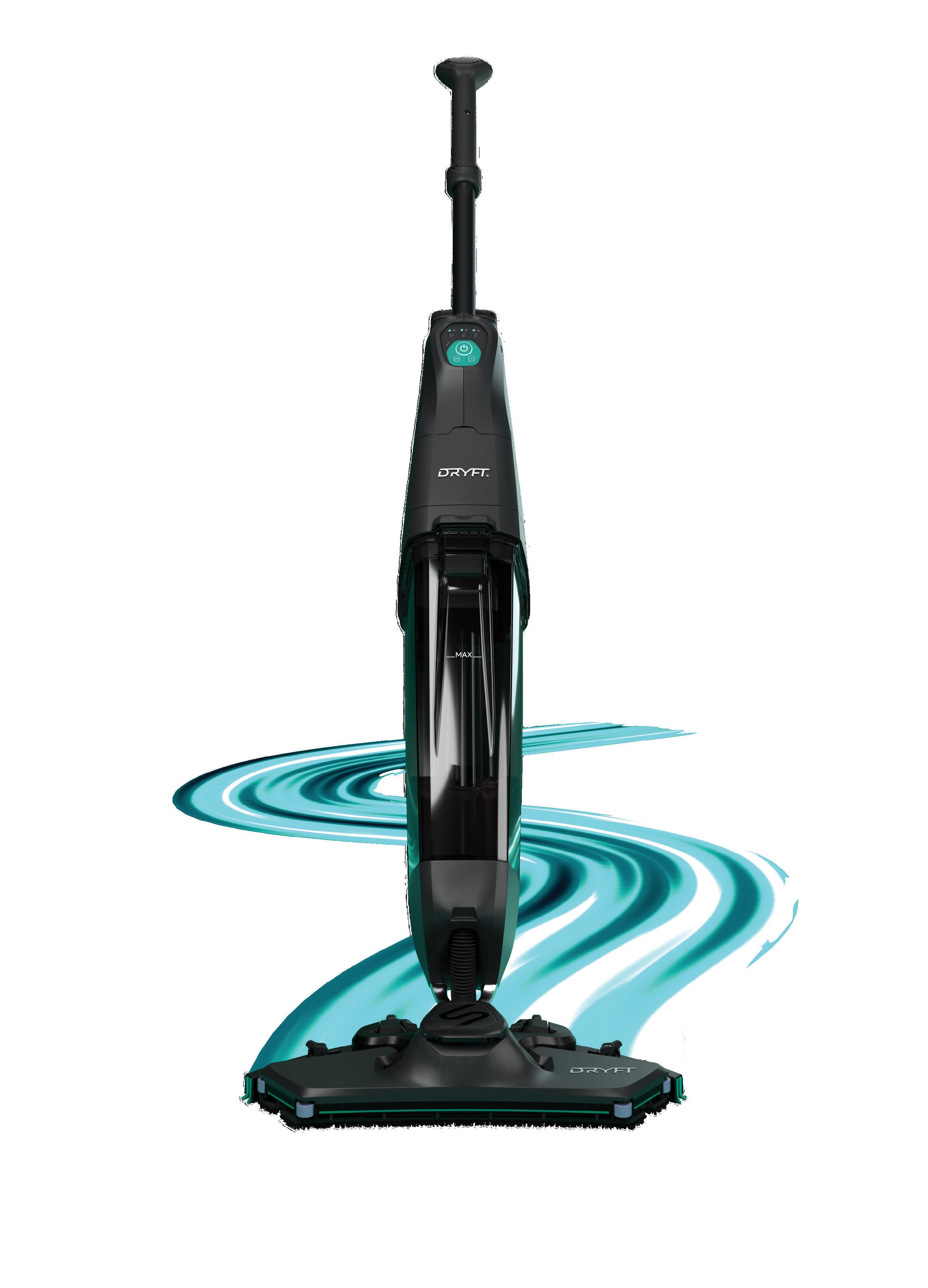







Words Tim McDonald
Indigenous-led cleaning and hygiene businesses are reshaping what it means to operate with purpose in Australia. Built on deep cultural ties, social impact and environmental leadership, these enterprises go beyond basic service. They’ve become role models, creating change at a structural level while remaining grounded in community and Country.
From commercial contracts to frontline sustainability innovations, these businesses are transforming the sector by bringing cultural responsibility and economic self-determination to the heart of operations. With strengthened procurement policies driving greater engagement and new generations stepping into leadership, the movement is gathering momentum.
For ARA Indigenous Services general manager Rohan ToblerWilliams, the strength of an Indigenous-led business lies in its connection to Country. “There’s nothing better than running a business on your own Country, or respectfully on someone else’s,” Tobler-Williams says. “It makes what we do feel bigger than just transactions. It’s about example, opportunity and control.”
Killara Services managing director Jasmine Newman echoes this sentiment. For Newman, cultural identity isn’t something kept separate from daily operations. “Our values guide how we treat our staff, our clients and the spaces we clean,” she says. “Respect is central for people, place and purpose. We start each day acknowledging where we are and who came before us. That awareness keeps our team grounded and proud of what we represent.”
Every May, National Reconciliation Week provides a moment for reflection. In this space, reconciliation isn’t symbolic, it’s embedded in daily business practice. As Gerrbik Laundry Services CEO Nicole Stewart says, “It’s not enough to just put on a breakfast during Reconciliation Week. True reconciliation means connection, opportunity and passing the torch to the next generation of leaders. There’s so much more we can do.”
Tobler-Williams concurs. "Reconciliation for us isn’t just about a week, it’s about a daily responsibility. We understand our role in leading that across the wider ARA Group – and if we can’t be a leader in our industry, then we’ve missed the mark."
At Gerrbik, a proudly Aboriginal-owned commercial laundry and dry-cleaning company, those ideals are lived through multigenerational leadership, community-first values and environmental innovation. “Dad started it for his family, and now I’m taking it on for mine,” Stewart says. “It’s not about me. It’s about showing that we can do this, generation after generation.”
Indigenous-owned cleaning businesses often operate as social enterprises, channelling profits into programs that deliver long-term community benefits. Gerrbik Laundry Services has invested in full-time Indigenous engagement managers to support new hires on their journey. “We decided early on to reinvest part of our profits, because hiring someone and just walking away isn’t enough,” Stewart explains. “You’ve got to protect the investment.”
That investment shows up in programs like WilaWila, which provides mentoring, weekly check-ins and recognition for team members across national contracts. “From Zoom meetings to awards nights, it’s a place of belonging in a business that can feel very big,” she says.
For Newman, it’s also about equipping people with more than technical skills. “We run training programs that go beyond the mop and bucket. We teach budgeting, time management and leadership, real-life tools,” she says. “I’ve seen women come in shy, not making eye contact, and within months they’re running sites and mentoring others.”
The rise in Indigenous-led businesses owes much to a maturing procurement framework. The Australian Government’s Indigenous Procurement Policy (IPP) has evolved into a powerful lever for driving First Nations participation in the economy. Under new updates coming into effect from July 2025, federal portfolios must ensure that at least three percent of contracts are awarded to Indigenous businesses, a figure set to climb annually until it reaches four percent in 2030.

For Stewart, the IPP is a vital mechanism. “It gives me the freedom to invest back into the community and support the passions that matter,” she says. “But there’s still a long way to go in how government and corporations really engage with it.”
Newman adds that while the IPP has opened doors, the path forward still requires grit. “The IPP changed everything for us. Before, it felt like we had to prove ourselves ten times over. Now, there's a pathway,” she says. “But it’s not always smooth. There are still systems that aren’t made for us. We’ve had to learn fast and lean on each other.”
Scaling up is no small feat, particularly when structural inequalities linger. “Capital is always a struggle,” Newman explains. “We don’t always have family backing or easy access to loans. And building trust with big clients takes time. There’s still a lot of unconscious bias out there.”
The business is also trialling no-plastic systems for airline linen services. “We work heavily in the airline space where plastic use is massive,” she says. “Others will follow, but it’s a big step.”
Beyond cleaning alone, these businesses restore pride in those who’ve lost their self-worth. Newman recalls one young employee who transformed within months. “She came to us after being out of work, dealing with trauma and low confidence,” she says. “Within six months, she was running her own team. She told me, ‘You didn’t just give me a job, you gave me back my pride.’ That’s what this is about.”
Stewart echoes this. “Running a successful business builds confidence,” she says. “It means people can buy homes, create stability and show younger generations what’s possible. One decision, one business, can change a whole

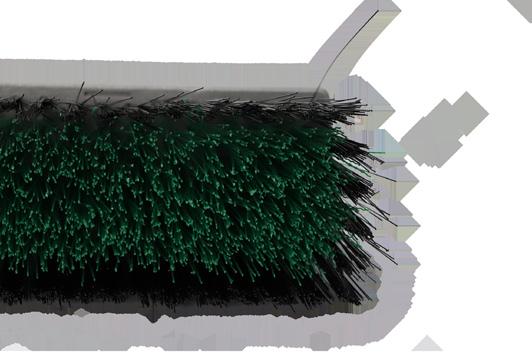
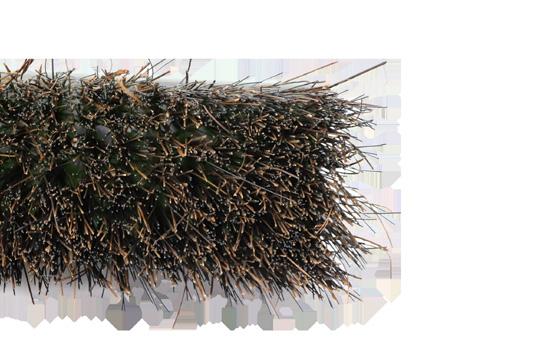






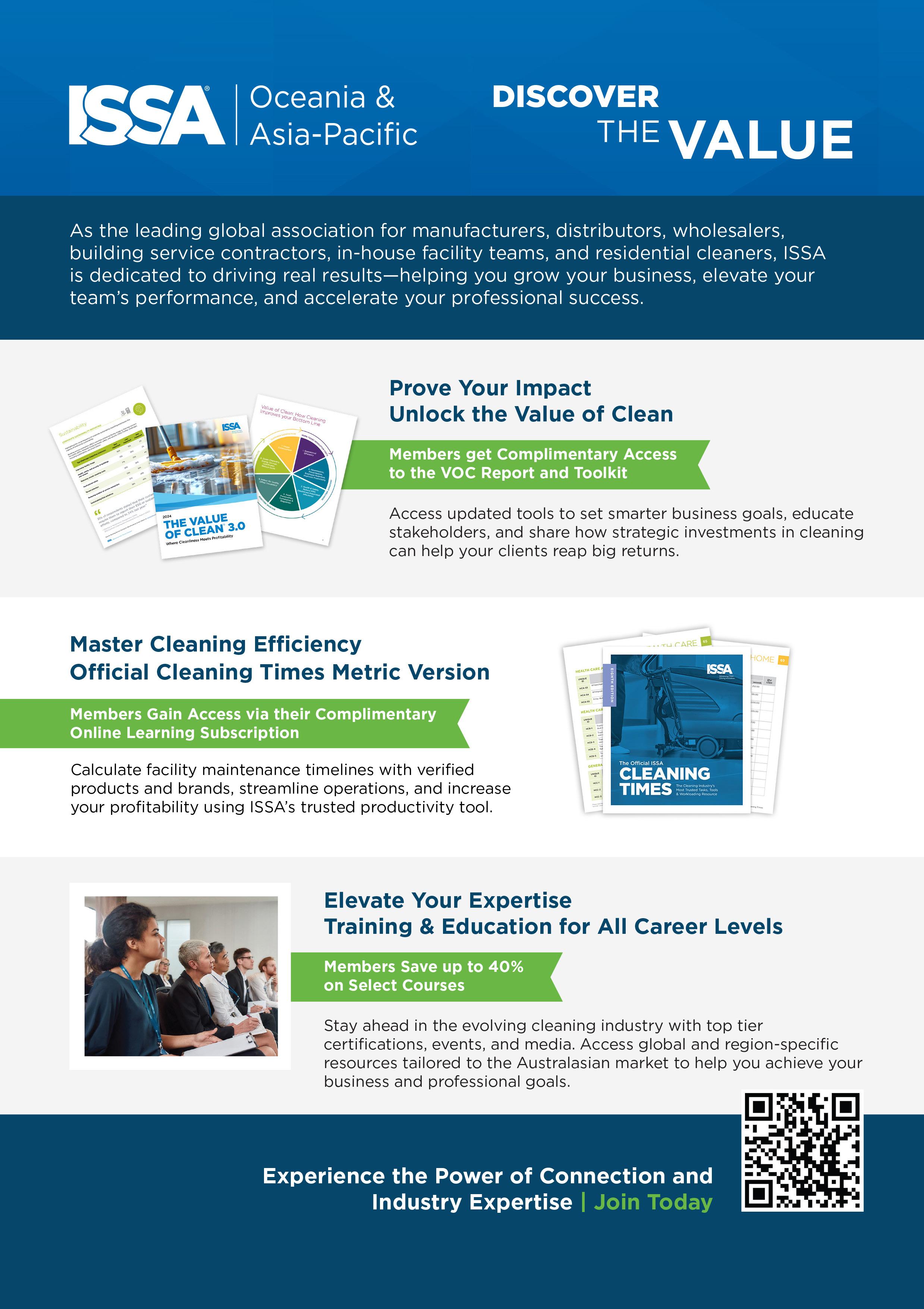

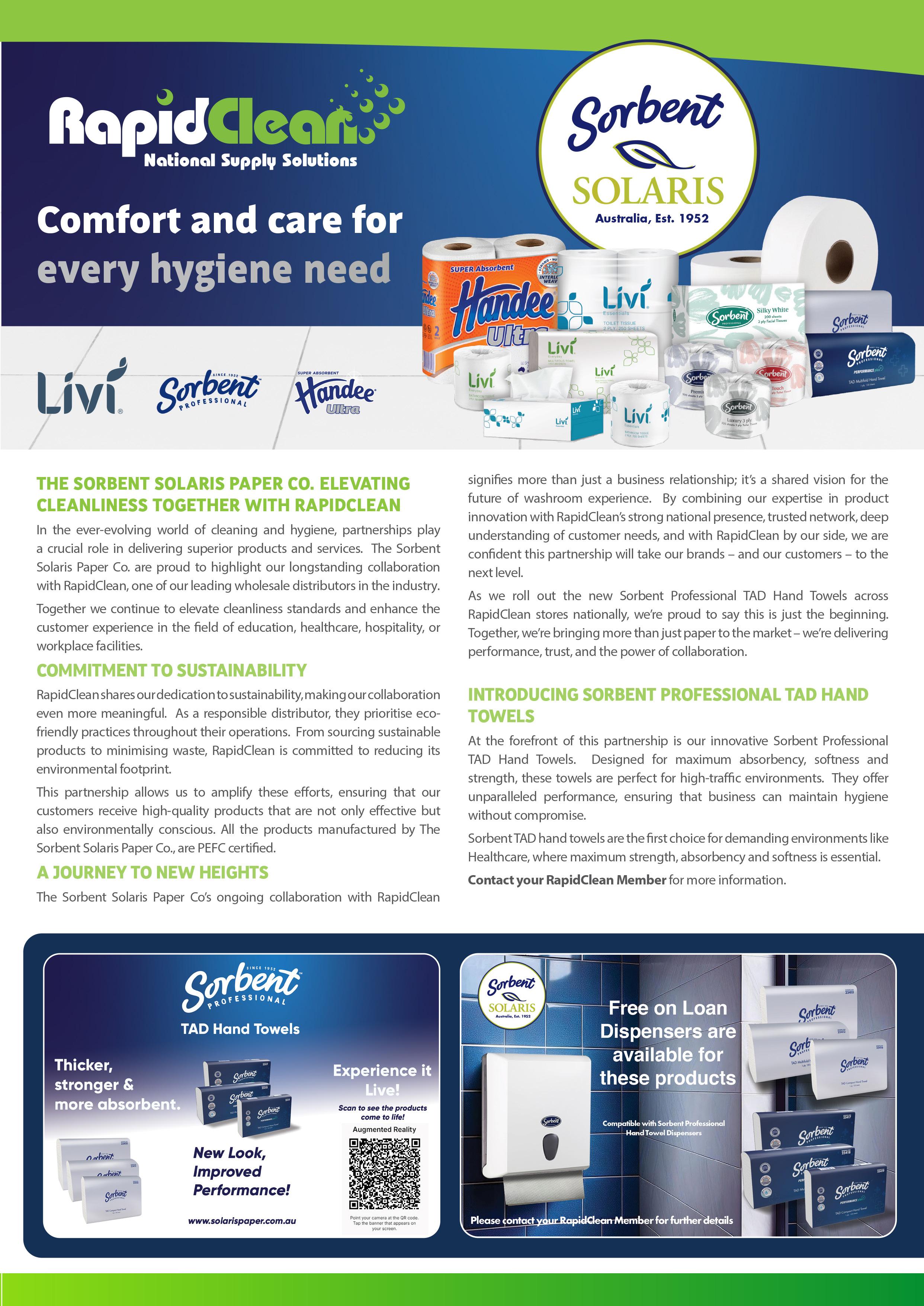
Tennant's micro scrubber range is transforming the way facility managers approach cleaning practices in compact spaces.

Facility managers are under more pressure than ever with tighter budgets, higher expectations and a shrinking labour pool. But one cost that often flies under the radar? Sticking with outdated tools like mops and buckets. They’re slow, physically demanding and in many cases, they leave behind more bacteria than they remove.
Tennant’s micro scrubber range, including the CS5 and CS16 is changing that. Compact, efficient and easy to operate, these machines are designed to replace traditional cleaning methods and deliver a measurable return on investment from day one.
Let’s face it, mops don’t clean, they smear. And a strong chemical smell doesn’t
guarantee hygiene, in fact, it can mask poor cleaning practices. In tight, hightouch areas where larger scrubbers can’t go, mops fall short. Tennant’s micro scrubbers offer a faster, more hygienic solution.
1. Faster clean times = higher productivity
Built for agility and performance, the CS5 and CS16 remove dirt, bacteria and moisture in a single pass. Floors are left visibly clean, hygienic and dry, ready to be walked on within minutes. Perfect for fast-paced environments that can’t afford long downtime. In fact, cleaning tasks can be completed up to 70 percent faster than with a mop and bucket.* That means fewer labour hours and more time for staff to focus on higher-value tasks.
2.
With high-quality cleaning in a compact form, Tennant micro scrubbers offer a far more effective clean than manual tools. By removing grime and bacteria instead of redistributing it, they deliver a consistent, measurable hygiene standard.
This is especially important in environments like aged care facilities, childcare centres and food retail where infection control and visual cleanliness are non-negotiable. Better hygiene contributes directly to improved health outcomes and customer satisfaction, a long-term ROI that's hard to quantify but essential.
3. Smarter resource use
Cleaning efficiency is more than time and labour, it’s the responsible use of water, chemicals and power. Tennant’s micro scrubbers are designed to be light on consumables, delivering great results while helping businesses shrink their environmental footprint. By using less water and chemicals per clean, facilities reduce ongoing supply costs and make progress toward sustainability goals, another area that is fast becoming a procurement priority.
You don’t need a large footprint to make a large impact. With Tennant’s CS5 and CS16, you get professional results, faster cleaning, lower costs and healthier spaces, all in a machine that fits where others can’t.
Upgrade your cleaning performance and your ROI with Tennant’s micro scrubber range. ■
In a climate of economic volatility and heightened risk, commercial cleaning operators across Australia and New Zealand are facing a mounting threat that’s harder to scrub away – soaring insurance premiums.
Words Tim McDonald
From public liability to workers’ compensation, the cost of cover is climbing fast, creating serious financial strain for businesses in the sector. The result? Thinner margins, tougher operating conditions and, in some cases, difficult decisions about service levels, staffing and growth.
Insurance costs are climbing across many industries, but cleaning businesses are feeling the sharpest blow. Often labelled ‘high-risk’ by insurers, they face mounting premiums due to the nature of the work, frequent claims and growing legal exposure from slip and fall incidents.
The cleaning industry isn’t alone in feeling the pinch. The insurance market has been considered ‘hard’ since 2018, characterised by high premiums and tighter underwriting standards. However, sector-specific conditions are now turning up the heat.
Industry insiders point to several contributing factors: inflation in claims settlements, rising medical costs linked to workplace injury, higher frequency of litigation and increased scrutiny on compliance in a post-COVID landscape. The growing cost of materials and labour has also increased the value of claims, making every incident more expensive to resolve. For insurers, this adds pressure to either recoup losses or reduce exposure, and cleaning is often the first to feel the fallout.
In Australia, the shift to a national workers’ compensation scheme is also creating new complexities around premiums
and claims management. Small businesses say the lack of consistency across state systems has made it harder to plan, while brokers are warning that ongoing reform may push premiums higher before the system settles.
For cleaning companies, the financial impact is being felt across the board, from large national firms to niche operators working in healthcare, aged care and retail. In some cases, insurance costs have doubled or even tripled in just a few years.
Public liability and workers’ comp are the biggest pain points. According to industry brokers, insurers are now applying more exclusions, increasing excesses and demanding more documentation, including everything from chemical safety protocols to staff induction records.
Much of the pressure stems from slip and fall claims, which remain a major driver of risk. “Slip and fall incidents continue to be a significant factor in insurance claims within the commercial cleaning sector,” says Australian Slip Testing managing director Ben Yarham. “This is rarely about negligence; more often, it reflects the challenges involved in maintaining safe floor conditions across diverse environments.”
According to Logic Business Resources CEO Lorraine Rogic, compliance documentation is one of the most underestimated risk factors. “Proper documentation isn’t just a compliance tool, it’s your defence when a claim is made. Without it, businesses are incredibly vulnerable,” Rogic says.

Higher premiums are reshaping business models, with some cleaning companies absorbing the cost while others are passing it onto clients. A few are cutting corners in ways that raise further risk, such as reducing training hours, delaying equipment upgrades or skimping on documentation.
“There’s a major gap I come across far too often, and that’s the lack of communication, consultation, internal training and verification of competencies,” Rogic says. “Despite regulatory awareness, many cleaning businesses still take a reactive approach to safety and issues are only addressed after incidents occur.”
There’s also growing concern that some operators are going uninsured altogether or taking out minimal cover to meet tender requirements without adequate protection.
For facility managers, building owners and procurement teams, this raises serious questions. An underinsured contractor could expose them to liability if something goes wrong. It also muddies the playing field, as responsible operators who maintain full cover are being priced out of contracts.
Despite the challenges, experts say there are steps businesses can take to reduce their exposure and their premiums. The first is to treat insurance as a risk management partnership, not just a transaction. That’s where independent, accredited slip resistance testing is gaining traction.
“We’ve noticed growing demand for slip resistance testing from both cleaning companies and their clients, which reflects an increasing focus on safety regulations and managing liability risks,” Yarham explains. “This demand is especially strong in high-traffic areas like shopping centres, commercial buildings and airports, where regular testing helps demonstrate compliance and meet insurance requirements.”
Underwriters are placing growing value on objective evidence of compliance, especially when it comes from trusted providers.
“NATA-accredited slip resistance test reports play an important role in insurance assessments and claims investigations,” Yarham says. “They allow insurers to assess whether a property complies with Australian Standards and can directly impact decisions around premium pricing and coverage eligibility.”
He says regular testing, backed by professional reporting, demonstrates due diligence and can reduce liability exposure.
“In the event of a claim, accredited reports carry significant weight in legal proceedings by offering credible, unbiased evidence that unaccredited reports lack,” he adds.
Rogic says the rise in workers’ compensation costs is another major concern. “Cleaning companies with poor safety records may see their workers’ compensation premiums rise by as much as 50 percent over time,” she warns. “The most common WHS breaches I come across are failures to conduct site-specific risk assessments, non-compliance with manual handling procedures, and inadequate or missing Safe Work Method Statements.”
Slip and fall incidents continue to be a significant factor in insurance claims within the commercial cleaning sector.
- Ben Yarham
Despite regulatory awareness, many cleaning businesses still take a reactive approach to safety.
- Lorraine Rogic
According to Yarham, one of the biggest gaps in compliance is not negligence, but inconsistency. “Without ongoing assessments, changes in surface conditions due to wear, contamination or cleaning variations can be difficult to track,” he says. “Another issue is impartiality. When testing is carried out by the cleaning company itself, there can be concerns about objectivity. That’s why we’re seeing an industry-wide shift toward using independent, NATA-accredited providers.”
But testing is only part of the solution. Yarham stresses the importance of aligning cleaning practices with testing cycles to maximise safety outcomes.
“Where possible, it’s beneficial to schedule testing shortly after treatments like a strip and seal or after a deep clean. That way, results reflect the surface in its optimal condition,” he says. “A good testing provider will usually coordinate with building managers ahead of time to prioritise specific areas.”
As for the tests themselves, Yarham says two in-situ methods are typically used: wet pendulum testing and dry floor friction testing.
“The wet pendulum method is suited for wet areas like amenities and walkways, while dry floor friction testing is used for smooth, dry surfaces such as foyers or back-of-house zones,” he explains. “Often, both are used together to give a complete picture of surface safety.”
While Australian Standards remain the benchmark, Yarham says insurance requirements are not one-size-fits-all.
“Insurance requirements can differ from one provider to the next, so it’s always worth clarifying expectations with your insurer or a qualified advisor,” he says.
Slip resistance needs also vary based on the building type and use.
“Amenities in shopping centres or aged care facilities carry a higher slip resistance rating than hotel apartments, for example. These variations reflect the need to tailor cleaning and safety practices to each environment.”
Rogic adds that psychological risk is a growing factor in both compliance and claims. “We’re seeing a significant increase in psychological injury claims across the cleaning industry, reflecting broader societal trends and the psychological toll of high-pressure cleaning roles,” she says.
There’s no silver bullet for insurance pain. But as premiums rise and risk exposure grows, the cleaning industry is being forced to adapt, and fast. Insurers are watching closely as regulators tighten standards and clients are asking tougher questions.
For now, the best defence is a clear, auditable story about how your business manages risk. Because when insurance becomes a battleground, proof is power. And that proof starts from the ground up. ■


Garth Michalson Managing Director Cleanstar

Cleanstar has always believed that cleaning smarter starts with choosing the right tools. But in 2025, it’s no longer just about individual machines. It’s about how they work together.
“Today’s commercial cleaners don’t just want performance, they want cost savings, time efficiency, productivity, ergonomics and flexibility,” Cleanstar managing director Garth Michalson says. “That’s why we’re building systems, not just selling products.”
This system-based thinking is what’s behind Cleanstar’s new wave of bundle offerings, like pairing the battery-powered PROSTAR backpack vacuum or the Italianmade T1 Backpack with the revolutionary ACTIV8 cordless vacuum head, for fast and more productive workflows.
The result? Cleaner spaces, reduced fatigue, faster turnaround times and realworld cost savings.
Every product is designed with durability, productivity and user experience in mind. Cleanstar’s tailored

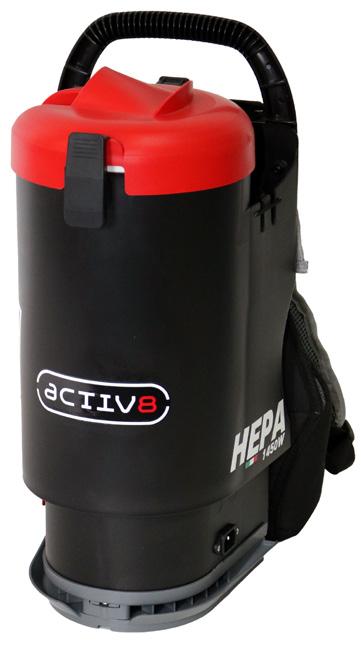
solutions and combined innovations are designed to help cleaners save time and money while significantly increasing productivity. “We’re here to help our customers not just keep up, but get ahead,” says Michalson. ■
Take cleaning efficiency to the next level with ACTIV8 – where innovation meets performance
Say goodbye to tangled cords and hello to cutting your vacuuming time in half. ACTIV8 is Cleanstar’s innovative battery-powered vacuum head engineered for maximum versatility on both carpet and hard floors.
Whether used as a stand-alone cordless sweeper or combined with a backpack vacuum for deep cleaning, ACTIV8 offers unmatched mobility, ergonomic comfort and time-saving performance. It’s the perfect solution for busy environments where efficiency matters most.
Lightweight yet powerful, ACTIV8 is proudly Australian-designed and built for commercial use turning routine cleaning into a smooth, effortless task with side-toside motion. ■
A
vacuum head that redefines the way the world vacuums:

• Designed in Australia for modern cleaning professionals
• Side-to-side motion – natural movement by standing upright
• Smart ergonomics – reduces operator fatigue
• Cut cleaning time in half
• Boost productivity, save labour costs
• Dual counter-rotating brushes for deep clean on hard or carpeted floors
• Vacuum powerhead + cordless sweeper in one
• Up to 3 hours run time – powerful and portable
• Fits most 32mm vacuum systems
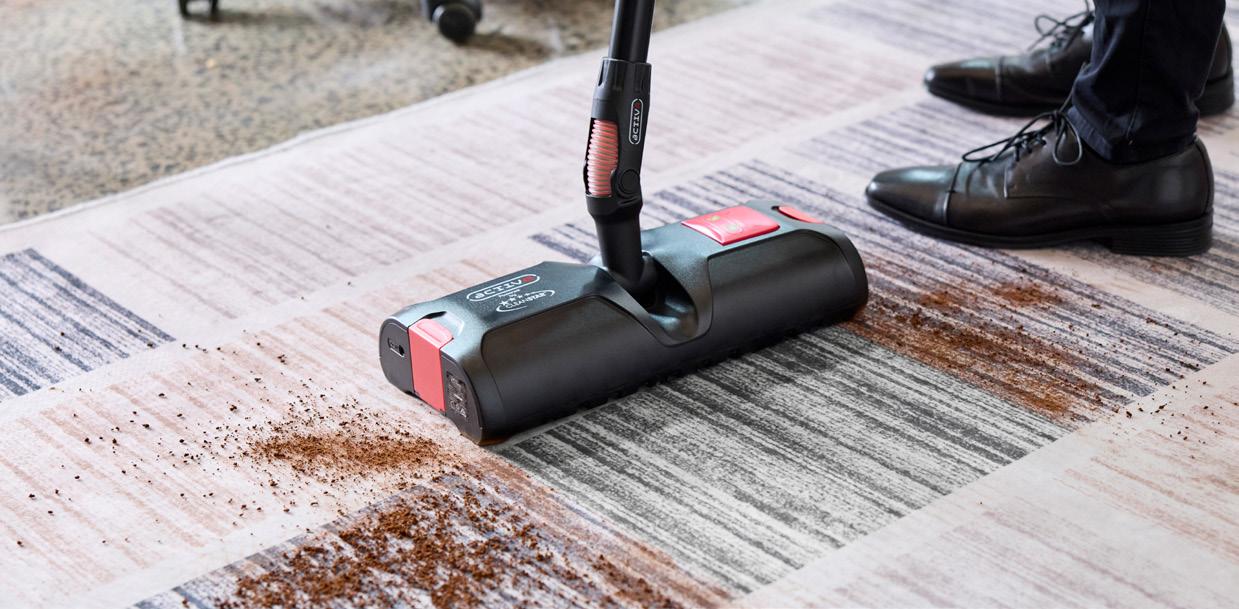

From productivity gains to cost savings, ACTIV8 doesn’t just clean, it empowers.

Clean anywhere, anytime - no cords, no limits
The ACTIV8 Battery Powered Vacuum Head and the PROSTAR Cordless Backpack Vacuum Cleaner: two groundbreaking tools designed to transform cleaning operations. ACTIV8 introduces a side-to-side mopping motion to vacuuming, allowing operators to clean while standing upright, significantly reducing strain and fatigue. Coupled with the PROSTAR backpack’s 36V cordless power, these tools offer unparalleled mobility and efficiency, making them indispensable for modern cleaning teams. This powerful combination equips your team with the tools needed to tackle any cleaning challenge with ease.
Bundle benefits:
• Enhanced efficiency Achieve faster cleaning times and higher productivity.
• Ergonomic design Reduce strain and fatigue with user-friendly equipment.
• Versatile functionality Seamlessly transition between vacuuming and sweeping tasks.
• Cost savings Enjoy special pricing when purchasing the bundle.
Contact Cleanstar on (03) 9460 5655 or sales@cleanstar.com.au to learn more about the ACTIV8 + PROSTAR Bundle Offer and how it can benefit your business. Available from cleaning supply stores. ■
High performance. Faster results. Built to last
In the world of professional cleaning, performance and reliability matter more than ever. That’s why the ACTIV8 Battery Powered Vacuum Head and the T1V3 Italian-engineered Ghibli Backpack Vacuum are the perfect match for those who demand strength, precision and results.
ACTIV8 delivers advanced cleaning efficiency through its unique side-to-side mopping motion, making floor cleaning faster and more ergonomic. Paired with the T1V3, a 1450-watt powerhouse built in Italy for commercial-grade performance, this duo is designed to handle heavy-duty cleaning environments with ease and consistency. Together, they form a powerful, professional-grade cleaning system, ideal for operators who require high performance, all-day comfort and exceptional results.
Bundle benefits:
• Maximum power talian-engineered suction meets Activ8’s deep-clean technology
• HEPA H14 filtration Five-stage filtration system for cleaner air and healthier environments
• Ergonomic and durable Built for comfort and designed to last in tough conditions
• Speed and coverage Cut down on cleaning time while improving surface results
• Bundle value Special pricing available when purchased together.
Contact Cleanstar on (03) 9460 5655 or sales@cleanstar.com.au to learn more about the ACTIV8 + T1V3 Bundle Offer and how it can benefit your business. Available from cleaning supply stores. ■
• Full cordless freedom = zero cords, total mobility
• Includes 4x batteries for non-stop run time
• 2-speed motor: Eco + Boost modes
• Lightweight with ergonomic harness for all-day use
• Energy efficient with HEPA filtration
• Perfect for high-traffic areas and agile cleaning teams
• No plug-in, no delay, no limits
ACTIV8 + T1V3 Ghibli Backpack:
• 1450W max power meets ACTIV8 precision
• 5-stage filtration with HEPA H14 filter
• Industrial strength for deep, fast cleaning
• Ideal for larger commercial spaces
• High-performance vacuuming with ergonomic design
• Reduce cleaning time, increase efficiency
• Powerful suction, smarter movement


For those who demand strength and precision, this is your go-to combination.
The annual ISSA Cleaning and Hygiene Expo returns to Sydney in 2025.

As the cleaning and hygiene industry continues to evolve, the ISSA Cleaning & Hygiene Expo is once gain poised to take centre stage. Returning to the International Convention Centre (ICC) Sydney on 29–30 October 2025, this two-day event will serve as a key platform for showcasing new products, exchanging ideas and driving meaningful change across the sector.
Building on the success of previous years, the 2025 expo promises a dynamic mix of live demonstrations, thoughtprovoking education sessions, and hands-on access to the latest innovations shaping the future of cleaning and facilities management.
Last year, the event drew over 2700 professionals from 29 countries and 2025 is set to be even bigger and better, with the expo firmly establishing itself as the industry’s go-to gathering. “What is clear is that this is more than just a trade show. It’s a catalyst for connection, innovation and progress.” ISSA Oceania manager Lauren Micallef said.
This sentiment was supported by Makita Australia business development manager (commercial cleaning) David Lincoln. “We’ve seen firsthand the value of engaging directly with attendees and sharing our expertise at the important Event,” he said.
This year features an exciting line-up of local and international exhibitors ready to showcase their latest innovations and solutions.
Cleanstar director Lisa Michalson said it was “crucial for businesses to remain at the forefront of new technologies
and solutions”. “Events like the ISSA Cleaning & Hygiene Expo drive innovation across the sector and help ensure we’re equipped to meet changing customer needs and rising standards,” Michalson said.
Both returning and first-time attendees to the show will not be left disappointed. “We are incredibly proud of the ongoing support we have received from the industry and our exhibitors,” Micallef added. “It is also exciting to see the number of new exhibitors taking part.”
As first-time exhibitor and sponsor Ryobi Commercial highlighted: “Ryobi Commercial is proud to participate in this premier industry event, connecting with procurement leaders and decision-makers. We’re committed to helping professionals streamline operations, drive value and achieve long-term success,” national commercial sales manager ANZ Paul Higginson said.
In an environment defined by rapid change, disruption and competing priorities, the ISSA Cleaning & Hygiene Expo offers a powerful platform for the industry to come together, recalibrate and move forward with clarity. Amid evolving regulations, rising expectations and economic pressures, the event provides a space for professionals to connect and gain the insights needed to navigate the current landscape and lead with confidence.
Wayne Hill, CEO at RapidClean added: “The industry is evolving rapidly, which makes events like this essential. They help businesses stay prepared, uncover the support they need, and find the right solutions for both current and future challenges.”
A core strength of the ISSA Cleaning & Hygiene Expo 2025 lies in its forward-thinking education program, which tackles the real-world challenges shaping the industry today. This year’s lineup of panels and presentations goes beyond buzzwords, offering deep dives into the practical, financial and ethical dimensions of cleaning. From managing supply chain risks to meeting new sustainability expectations, the sessions are curated to give professionals across the cleaning, hygiene and facility management sectors the tools they need to lead with confidence.
Sustainability and performance will be a central focus. Attendees can expect honest discussions about the realities of implementing ESG initiatives, balancing environmental goals with operational effectiveness, avoiding greenwashing and navigating evolving regulations. “The expo provides an outstanding platform for us to share our latest advancements and connect with industry professionals who share our commitment to quality and sustainability,” Rubbermaid Professional senior marketing manager Praj Perera said. Other sessions will examine how cleaning is being redefined by building science and practices across sectors like education, hospitality, aged care and other public Spaces.
“Our industry and the work we do are becoming more datadriven and science-based.
“[We’re] linking clean buildings to human clinical outcomes and bringing the right people to the table at the right time”, said Dr Gavin Macgregor-Skinner, adding that professionals now have the opportunity to become “disease detectives” through specialised training and collaboration with other industry experts. As economic pressures mount, panels will equip businesses with strategies to rise above price-driven competition. These sessions will look at how cleaning professionals can reposition services around measurable outcomes, highlighting the true value of professional cleaning.
Meanwhile, discussions around data, digital transformation and AI will provide attendees with insights into how emerging technologies are shaping procurement, scheduling and performance tracking in ways that increase efficiency without sacrificing quality.
“The expo is a powerful platform for connecting with the industry and showcasing how flexible, smart workforce tools can help businesses overcome real-world challenges,” iQCheckPoint senior manager of strategy and growth Steven Tanusoski said.
Finally, the expo will offer sessions that tackle critical compliance and safety issues, including infection control in healthcare, the rise of cleaning verification standards, and legal risks in slip-and-fall incidents. As the expectations around hygiene, documentation and accountability continue to rise, these discussions will ensure attendees are equipped with the right protocols, data and training to protect their organisations and clients.
“Cleaning and healthcare are an ever-changing landscape,” Master Cleaners Training Institute CEO Liezl Foxcroft said. “Sites will need to continue to evolve, especially with growing ageing populations, which in turn results in more specialised cleaning. This is where a challenge lies and will be more broadly addressed throughout the expo’s education program.” The ISSA Cleaning and Hygiene Expo show floor education will feature 14 sessions and over 30 thought leaders ready to share their expertise. For

those looking for a deeper dive into technical training, onsite workshops will be taking place throughout the two-day event.
Whether you’re a cleaning contractor, facilities manager or supplier, the 2025 education program delivers insights that are not just timely but essential.
One of the most anticipated elements of the expo is the return of the ISSA Excellence Awards, which shine a spotlight on the innovations redefining the cleaning and hygiene space. These awards recognise excellence across six categories: Equipment, janitorial, paper and dispensing, service and technology, cleaning agents, as well as environmental awareness and sustainability.
All award finalists will be displayed in the Innovation Zone, a dedicated area on the show floor where attendees can explore entries up close.
“These awards celebrate the creativity and problem-solving that continue to move our industry forward,” Micallef said. “From safety to sustainability, the innovations on display represent the very best of what our industry can achieve.”
Award winners will be announced during a special networking evening on 29 October 2025. This event brings together suppliers and buyers for a relaxed opportunity to connect, exchange ideas and celebrate industry excellence. The People’s Choice winner will be revealed on 30 October and determined by the industry and live show floor voting.
Whether you’re looking to sharpen your business strategy, connect with top suppliers, explore hands-on demonstrations, or simply stay ahead of industry trends, The ISSA Cleaning & Hygiene Expo 2025 is the place to be. Backed by the global network of ISSA, the worldwide cleaning industry association, this event is more than just a date on the calendar. It’s a movement toward smarter, safer and more sustainable cleaning practices across the region. ■
For more information visit cleaninghygieneexpo.issa.com/. The ISSA Cleaning and Hygiene Expo 29-30 October, 2025, ICC Sydney
As
demands rise for low-impact operations, cleaning equipment is undergoing
a quiet, methodical transformation rooted in robust engineering.
Words Tim McDonald
Anew kind of cleaning machine is emerging. It doesn’t whirr louder, spray further or scrub harder. Instead, it thinks in cycles, consumes less and leaves behind a faint footprint, both physically and environmentally.
For facility managers tasked with reducing their carbon footprint without compromising on standards, cleaning equipment has become a pivotal piece of the sustainability puzzle. Yet beyond the buzzwords and badge-collecting lies a deeper engineering evolution that deserves attention — how materials, mechanics and manufacturing are being reimagined to support more regenerative approaches to hygiene.
There’s no shortage of surface-level claims about ‘eco-clean’ equipment. Machines are branded as green because they use less detergent, or batteries marketed as ‘non-toxic’ but encased in petroleum-based plastic. Yet the next generation of cleaning technology is moving beyond these tropes.
At the centre is lifecycle design. Engineers are increasingly tasked with building machines that consume fewer resources over their lifespan, from extraction to end-of-life. This means revisiting fundamentals like weight, modularity and even the algorithms that determine motor load during use.
According to Ashkin Group CEO and president Stephen Ashkin, the next three to five years will bring deeper focus on “ergonomics, efficiency, automation and connectivity” in equipment design. He says the shift won’t just be technical. It will reshape how facilities plan, purchase and maintain their fleets.
“Expect more ergonomically designed tools that reduce worker injuries, along with equipment that’s durable and repairable to
extend life and cut waste,” he explains. “Connectivity will improve equipment maintenance, and advances in energy and water efficiency will lower operating costs and environmental impact.”
Ashkin also points to autonomous robotics, particularly hard floor and carpet cleaners, as one area of promise, offering consistency while reducing labour demands. But he cautions that technology alone isn’t the answer. “Facility managers should be meeting with prospective suppliers, updating specs, improving training and rethinking their purchasing priorities with sustainability front of mind.”
One of the most striking developments is the transition to highefficiency, low-load motors that operate more quietly and draw less energy without sacrificing performance. It’s less about brute force, more about mechanical finesse. Engineers are adjusting torque curves, optimising gear ratios and refining brushes and pads to reduce drag.
These advancements result in a compact battery scrubber that can now cover the same area as a larger model, but with a third less energy and vastly reduced water usage.
These refinements go beyond technical upgrades. They’re changing workflows, enabling facilities to run day-cleaning programs in sensitive environments, thanks to quieter machines. Battery life extends across longer shifts, cutting downtime, while reduced water use means faster dry times, lowering slip risk and improving safety.
Sustainability in commercial cleaning does not begin on the factory floor, says Cleanstar’s customer service manager Ginny Bebbington. It starts with smart decisions made by buyers, facility managers and cleaners themselves.
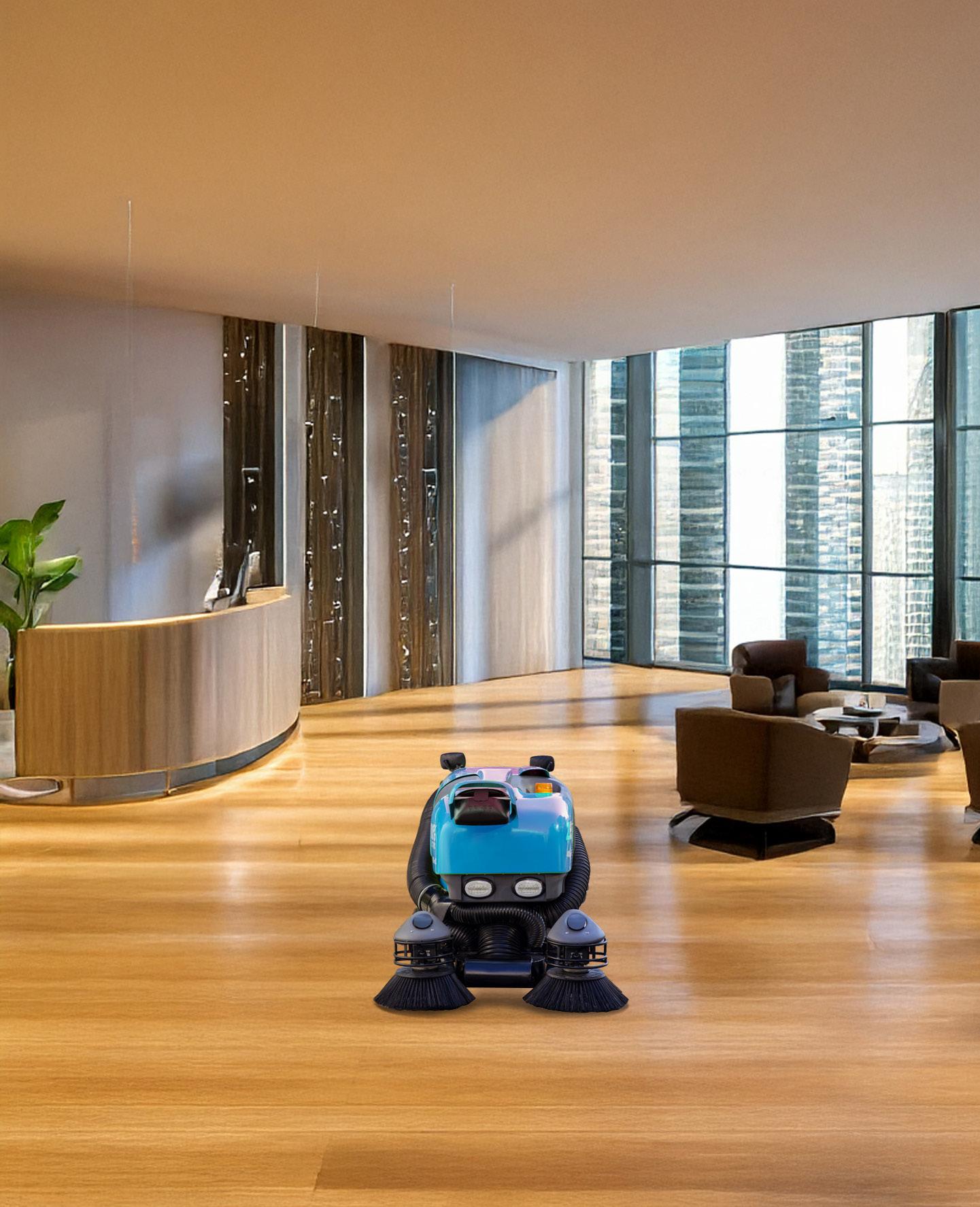
Most machines are still discarded because of a single component failure, like a board or battery. If those parts
were
standardised and swappable, the whole machine could stay in service longer.
“The quality of the machine plays a huge role,” says Bebbington. “If you’re replacing vacuums every six months, you’re wasting materials, transport and labour. But if you choose wisely, you’ll be using the same machine five, 10, even 15 years down the line.”
That level of longevity requires more than robust engineering. It depends on access to parts, reliable technical support and machines designed for maintenance, not disposability. Cleanstar, which supplies and supports a vast range of commercial equipment from floor scrubbers to carpet extractors, sees firsthand how equipment failure can be prevented with the right planning.
“It’s often small things — a blocked filter, a broken hose, something avoidable,” Bebbington explains. “If we can help someone fix a machine in five minutes instead of sending it to landfill, that’s a win for everyone.”
Education also plays a part. Bebbington says buyers are increasingly asking not just about the price tag, but about lifecycle costs, energy efficiency and repairability.
“There’s definitely more awareness now. The industry is getting better at looking at the long-term picture.”
That shift, she says, is where true sustainability lies — not in buzzwords or branding, but in how decisions are made, and who benefits from them in the long run.
Perhaps the boldest frontier in sustainable cleaning equipment lies in materials science. Traditional machines are built for durability, but not necessarily for end-of-life separation or circularity.
That’s changing. Several suppliers are trialling biopolymer casings, recycled-content tanks and components that can be easily disassembled without specialised tools. Some cleaning equipment distributors now offer closed-loop recycling for certain brands, taking back machines to salvage high-value parts before shredding and reprocessing the remainder.
But the biggest challenge isn’t recyclability. It’s cultural. “Most machines are still discarded because of a single component failure, like a board or battery,” notes one equipment service
manager. “If those parts were standardised, swappable or even designed to fail gracefully, the whole machine could stay in service longer.”
There’s growing interest in what’s known as ‘design for disassembly’ or DfD. This concept, long used in the tech and furniture industries, is now gaining traction in cleaning. Manufacturers are exploring click-fit connectors, screw-free shells and QR-coded parts for easy replacement. It’s all aimed at giving facility managers more control over maintenance and reducing waste.
Smart systems that once felt like overkill in cleaning are now experiencing a wave of sensor-driven equipment that’s proving its worth by optimising what already works.
Automated dosing, intelligent route mapping and predictive maintenance alerts are tools that quietly reduce resource consumption while giving operators clarity on how machines are performing in real conditions. For large sites with multiple teams, the ability to pull machine-use data from the cloud is now about insight over surveillance.
A final twist in the green machinery story is that many of the most forward-thinking models may not be owned at all.
More suppliers are offering machines-as-a-service, where equipment is leased, monitored and maintained as part of a performance-based agreement. This shifts responsibility for longevity and efficiency back to the manufacturer and incentivises better design. It’s also more adaptable for facilities under pressure to scale or pivot rapidly.
For cleaning teams, this means less capital outlay and more operational flexibility. For the planet, it means fewer idle machines sitting in storage rooms or landfills.
In the end, the greenest gear isn’t always the one with the loudest claim. It’s the one that’s engineered quietly, with intent, to last longer, work smarter and leave less behind. ■
Mental wellbeing for those working outside the nine-to-five is often overlooked, and it's time for a change.
Words Liam
The cleaning industry is filled with unsung heroes who keep the lights on long after many clock out. Across Australia and New Zealand, thousands of workers within the cleaning industry operate in near-invisible roles. After-hours cleaners play a vital role in society but scarcely receive gratitude or recognition.
Fatigue, isolation and loneliness are common maladies suffered by those working long shifts across unsocial hours. Sadly, not all employers pay attention to the wellbeing of their staff, and this lack of focus on those who keep our offices clean and co-working spaces hygienic leads to adverse mental health issues.
The Cleaning Accountability Framework (CAF), a worker-driven due diligence scheme based in Sydney and Melbourne, operates nationally to end the exploitation of cleaners and other after-hours service workers.
Two former cleaners, now working for CAF, are closely acquainted with the causes of adverse mental health. Pritika Karmacharya, a worker engagement manager within the organisation, cites a lack of education as a contributing factor to burnout and low moods.
While she speculates the cleaning industry has always experienced high employee turnover, the specific cause is likely due to uncertainties surrounding workplace entitlements.
“As most people working in the cleaning industry are migrant workers and international students, they have minimal knowledge about their workers’ rights,” Karmacharya says. “This makes them easily vulnerable to factors that can cause stress, such as workload, disrespect, discrimination and lack of harmony in the workplace.”
Jennifer Alonso, a worker engagement officer, draws on her own experience as a cleaner to cite casual work contracts as a major cause of mental strain. Being called in only when there are shifts available, she says, “creates a lot of pressure to do your best all the
time, because you want to be offered more shifts and hopefully become a permanent worker”.
Yet even the security of a full-time contract leads to other concerns, such as being asked to perform jobs for which a staff member hasn’t received proper training. The root of the problem links back to communication.
“Many cleaners feel they can’t give honest feedback or speak up without fear of retaliation,” Alonso says. “As international students or workers with families, we carry many responsibilities, which adds more pressure. Often we put our jobs first, even above our health, just to keep our income and stability.”

Finding a solution that works for everyone is a multifaceted process and one that requires input from all tiers of the workforce and higher management. Above all else, respect needs to be a core tenet of every workplace practice.
As Karmacharya asserts, “It shouldn’t just be about making the cleaning team feel heard: it should be about truly listening to them and being accountable for providing a better working environment.”
Alonso says offering permanent employment contracts within a reasonable time frame is another key consideration. “Staying casual for too long increases stress and insecurity,” she says. “A happy and supported worker will do a better job.”
She also stipulates that training needs to be allocated equally to staff members as well as team supervisors. “It’s not just about assigning someone to a leadership role. It’s about preparing them to create respectful and healthy workplaces. Listening to workers without judgment can make a big difference to mental health and overall job satisfaction.”
Another advocate for workplace mental health is Dr Amanda Biggs, senior lecturer in the Department of Management at Griffith University in Queensland.
Biggs highlights that a major proponent of workplace wellbeing is tied to the sense of purpose afforded by a fulfilling vocation. “Work can be really engaging when it gives us a sense of meaning,” she says. “When we have a sense of control and autonomy over what we're doing, when we have a sense of belonging, we feel like we're experiencing a sense of competence.”
A key change employers can make is simply showing their gratitude to their staff, especially those working unfriendly hours. Ensuring staff members feel seen and heard is a major contributor to better mental wellbeing at work. “Involve them in decisionmaking, too,” Biggs adds.
She says it is important to make sure staff are aware of things happening within the organisation. “Prioritising people's mental health involves giving them a voice in matters relating to their own health, so considering the psychosocial safety climate is something that I would also recommend,” Biggs says.
Building Service Contractors Association of Australia (BSCAA) chief executive officer Kim Puxty recognises the vital role played by cleaning staff, yet underlines the unique threats to their mental health in the workplace.
“These include physically demanding work, limited recognition and job insecurity or social isolation,” she says. “Many are also navigating complex immigration processes while adapting to new communities, often facing financial stress and language barriers.”
There are numerous maladies that can result when these factors remain unaddressed, such as burnout and diminished morale. Hanging over all of these issues is the one overarching experience of those in the cleaning industry: a lack of respect.
Despite their importance in maintaining hygiene and safety in work settings, Puxty asserts, “cleaners are often spoken down to, excluded from workplace interactions, or treated as lesser service providers. This undermines morale and contributes to emotional strain.”
The solution to providing cleaning staff with support must come from increased employer engagement. Puxty identifies that many organisations are already taking positive steps, with BSCAA, in particular, exercising “open communication, regular staff engagement, and identifying workplace risks. Employers can foster inclusive environments by recognising contributions, ensuring cleaners are treated with dignity and setting clear expectations with clients around respectful behaviour.”
In order to facilitate this change, however, ample support needs to be given to the shift supervisors who are tasked with safeguarding staff wellbeing. Puxty emphasises that streamlined workplace processes can effectively establish clear boundaries around after-hours contact.
“Simple communication protocols can go a long way in protecting work-life balance and maintaining high service standards, while also aligning with Australia’s Right to Disconnect laws. Only together can we build a stronger, more respectful, and supportive industry, one where every cleaner feels safe, valued and empowered.”
As most people working in the cleaning industry are migrant workers and international students, they have minimal knowledge about their workers’ rights.
Mental health within the cleaning industry remains just as vital an issue in New Zealand, where the industry employs a sizeable proportion of the population.
- Pritika
According to statistical research body IBISWorld, there were 26,000 people employed in the commercial cleaning services industry as of 2023. The sector also contributes $1.25 billion to the NZ economy, equivalent to two percent of the country’s GDP, according to 2022 findings published by Ringa Hora.
One organisation committed to worker wellbeing is Aucklandbased labour union E tū. Named after a Māori waiata espousing the value of standing tall in the face of any storm, the group represents 48,000 workers in New Zealand across six industries, including the cleaning services sector.
Since January 2024, Georgie Dansey has resided as director. Dansey openly advocates for cleaners to speak out about the mental health challenges they face every day.
“Too often, these essential workers are overlooked, yet they have the important role of keeping our schools, hospitals and workplaces safe and hygienic,” she says. “Cleaners frequently face disrespect or neglect from employers and the public, which undermines self-worth and morale.”
Dansey highlights several factors that contribute to low morale and impaired wellbeing within the cleaning industry. She says unrealistic workloads, unreliable employment contracts and unsustainable wages are all causes of significant anguish and worry.
Many cleaners work multiple jobs due to poor wages, Dansey says, which causes financial stress, as well as reduced time with their families. “The work is usually in shifts, with late nights and early mornings, which means cleaners are often working alone at night or in empty buildings.”
Dansey emphasises the responsibility of employers to recognise these factors and treat them with the respect they deserve. “Good mental health is not a luxury,” she says. “It’s a workplace issue.”
Dansey’s suggestions for what employers can do differently echo those of Alonso’s, such as offering secure employment contracts and achievable workloads. “Most importantly, employers must listen,” she says. “Cleaners know what they need, they just need to be heard and valued.” ■
If you are experiencing burnout or suffering from poor mental health at work, there are support services at hand. These include Lifeline Australia, Beyond Blue and MATES. Remember, you are not alone and help is available if you need it.
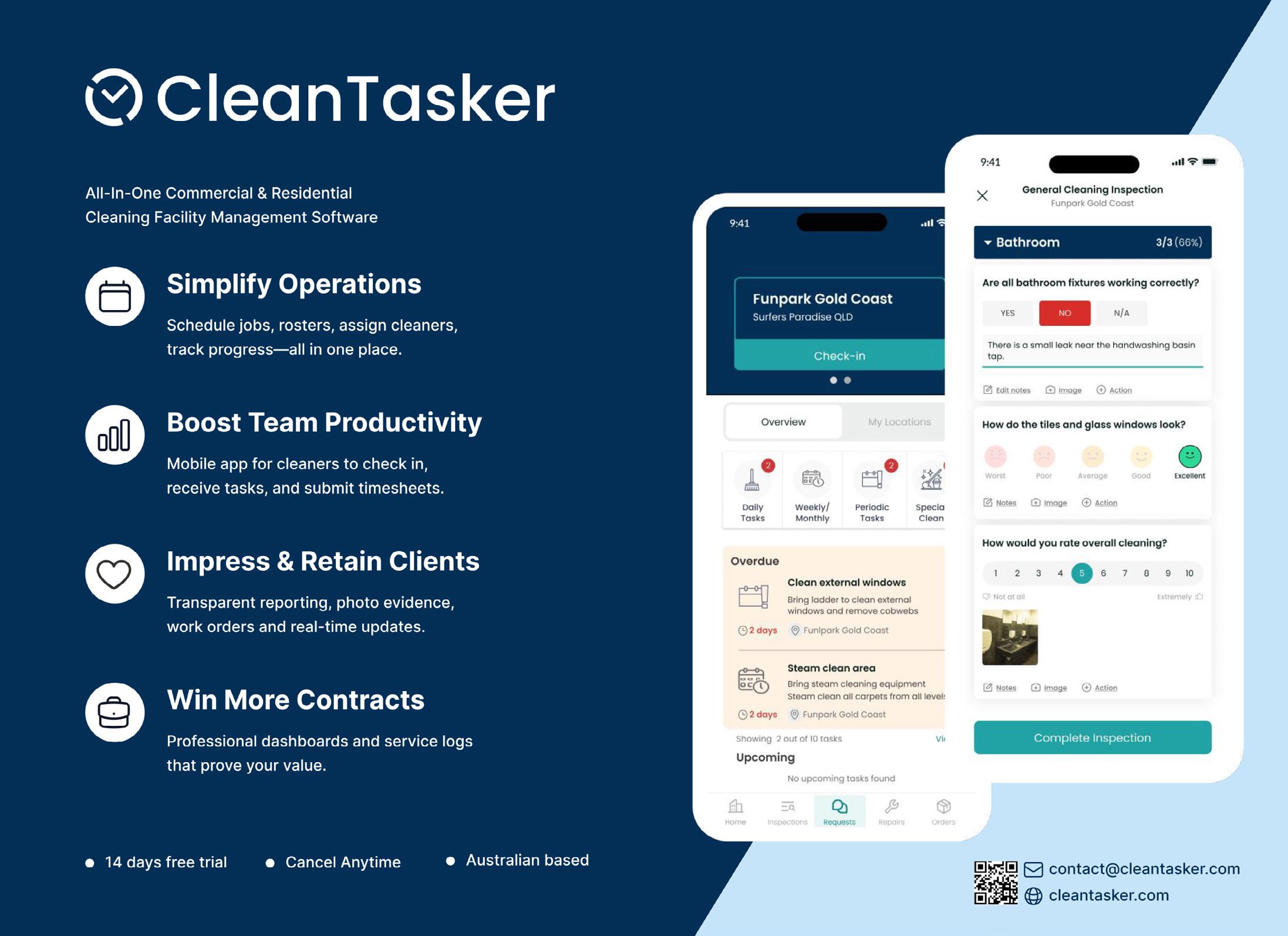
While companies strive to stay ahead of the curve by integrating the latest technologies into the cleaning space, here’s a look at what they must bear in mind.
Words Varun Godinho
It’s difficult to identify a single inflexion point as to when the integration of AI, Internet of Things (IoT) and automation into the cleaning sector became more visible, and in some ways even more necessary, than before. Certainly, though, the pandemic five years ago was a major catalyst. It was a period that ushered in the need for all-new cleaning regimes and solutions that were overall more autonomous.
The adoption of technology into the cleaning sector since then has been swift, extensive and transformative. From robotic floor cleaners to cutting-edge software that self-generates compliance reports, the scope of automation is wide and straddles both the physical and digital-first worlds.
While several players have been waving the flag for autonomous cleaning in Australia, two companies – cleaning equipment manufacturer Kärcher and robotic AI software firm Brain Corp – have stood out, laying a solid foundation for the industry’s tech advancements.
Andrew Dillon is a director at JCAL Risk Management and business development executive at Brain Corp, spearheading the company’s growth across Australia, New Zealand and South Korea.
Meanwhile, New Zealand-born, Melbourne-based Hamish Matheson is the region president for Oceania at Kärcher and has brought his experience in working with large US and European global organisations to the German family-owned company. Here, Dillon and Matheson outline the scope, challenges and the future of smart cleaning solutions in Australia.
Rather than wax eloquent about the hypothetical advantages of integrating technology into the cleaning space, Matheson cites real-world examples of its profound benefits. He explains that one of Kärcher’s customers in New Zealand shared the measurable impact the Kärcher KIRA B 50 had on their warehouse operations. That machine reportedly saved the organisation 360 minutes per week that would otherwise be spent by an employee, who was now reallocated to higher-value tasks. The autonomous cleaning robot also resulted in a 150 percent boost in cleaning frequency, cleaning 13,000 square metres daily.
Beyond numerical advantages, automation can also assist with important administrative tasks such as compliance. The cleaning

robots generate automated logs, thereby replacing manual recordkeeping and improving audit readiness. “AI-enabled cleaning tech such as KIRA also transforms compliance from what can be a complex and laborious task into a quick and seamless one,” Matheson says.
The path to automation does not involve building more capable robots, but rather better-trained models.
One way to deliver this is through regular software updates based on collected real-world data from hundreds of robots, which are independently improving their own performance across every mile travelled.
That shared data enables the system to make the robots ‘smarter’ over time in a real-world setting, outside the controlled testing facilities where they were initially developed.
“BrainOS-powered robots are specifically built to navigate realworld, unpredictable environments,” Dillon says. “We’re specialists in this area and you’ll find robots powered by BrainOS operating globally in warehouses, malls, airports, hospitals, and retail stores where crowds, obstacles and layout changes are part of daily life.
Any tech that promises to completely remove the need for humans in the cleaning industry is overhyped.
- Hamish Matheson
Thanks to a robust combination of cameras, LiDAR, 3D sensors and proprietary AI algorithms, they can detect, avoid, and reroute around people and objects in real-time.”
Another focus for automated cleaning manufacturers and service providers is adaptive cleaning, wherein robots learn from their environments and adjust their cleaning patterns in real-time based on external influences. “For example, think about when it rains and the foot traffic in shopping centres. Cleaning machines of the future will know it's raining based on weather signals and launch automatically to clean shopping centre entrances,” Matheson explains.
Automation in the cleaning sector does not need to be an eitheror choice between machines and humans, but rather a model where systems are automated and technologies are implemented only, and always, with humans in the loop.
Matheson says concerns over cleaning automation resulting in scores of redundancies are overhyped. “Any tech that promises to completely remove the need for humans in the cleaning industry, I would suggest, is overhyped,” he says. “The genuinely transformative machines have been carefully developed and engineered to improve efficiency and allow humans to focus on more complex cleaning tasks.”
Dillon, too, is clear that automated cleaning solutions are in no way intended to replace humans at a job that requires a considerable level of skill in order to execute complex tasks. “Many people assume robots can replace cleaning staff entirely, but Autonomous Mobile Robots (AMRs) are designed to augment – not eliminate – human workers, handling repetitive, highfrequency cleaning tasks so staff can focus on more detailoriented work,” Dillon says.
“Our philosophy is not about replacing people, but elevating the role of human workers to higher-value tasks. Our robots are designed to work alongside human teams as they handle other tasks. While the robots are autonomous in operation, human oversight is still important, especially for general machine maintenance and reviewing reports to ensure cleaning coverage is being maximised.”
Several challenges are associated with integrating technology into the cleaning industry. None of them are insurmountable in themselves, but tackling them requires a cross-departmental, across-the-floor buy-in from all those involved in implementing the technologies.
As Dillon says, there’s often a gap between what robots can do and what people think they can do. Education is crucial in bridging that gap. “Change can be hard,” he says. “Cleaning workflows are deeply embedded, and some teams fear disruption. That’s why we offer full support to ensure smooth onboarding, training and integration. Like any new technology, AMRs require a shift in existing processes. Without internal champions, adoption can stall.”
Dillon says, in large facilities, operators want solutions that “fit into existing systems, not create more work”.
Apart from integration issues, another challenge the industry faces is perceived high implementation costs, with some facility managers viewing robots as an avoidable capital expense rather than a productivity tool with a sizable return on investment in the long term, as it frees up staff for more valuable tasks.
Change can be hard. Cleaning workflows are deeply embedded and some teams fear disruption.
- Andrew Dillon
To address these concerns, companies such as Kärcher offer monthly leasing options for their robots, which are provided with no licensing or subscription fees, further reducing ongoing operational costs.
Another concern that automation must address is general data security. “In order to operate, robotic tech needs a certain level of information about your site, and it is crucial to ensure that any information it has is stored and managed safely while also complying with local data legislation,” Matheson says.
As the technology underpinning cleaning solutions evolves and becomes smarter, analysts suggest that there will be a greater interdependent relationship between employees and machines. Matheson views this relationship between automated cleaning technology and frontline staff as strengthening over the next few years. “Robotic cleaners cannot do everything a human can,” he says. “The real benefit lies in utilising the strengths of both robotic tech and cleaning staff for optimum results.”
This relationship is expected to give rise to a new generation of collaborative robots, also known as cobots. “Cobots will continue to enter the market, increasing performance and efficiency,” Matheson says. “This is most likely the cleaning tech that will stick.”
The direction that will likely define the path forward for the automated cleaning sector is best elaborated by Matheson, who calls for an industry-wide shift in perceptions and attitudes to integrating automated cleaning solutions. He says this will then determine the pace with which these technologies develop and are integrated into facilities.
“Those who have the best success in integrating automated solutions into their cleaning processes have embraced the technology and ensured there is ownership within their business and cleaning teams to get the best out of it,” Matheson says. “This includes manufacturer-supported training and support required to develop the appropriate mindset and skillset.”
The right mindset and skillset are what will truly move the needle for the industry. ■
The cleaning industry is raising the bar with smarter systems, stronger compliance and a commitment to low-impact solutions that prioritise people and the planet.
Words Tim McDonald
In today’s fast-paced commercial environments, the margin for error in chemical handling is shrinking. Facility managers are being asked to reduce environmental impact, improve workplace health and safety (WHS) outcomes and maintain clinical-grade hygiene – all without increasing operational complexity. To meet these demands, cleaning providers are embracing smarter systems, intuitive packaging and data-driven decision-making.
From automated dilution systems to real-time usage tracking, the sector is proving that sustainability and safety can go hand in hand.
Clear labelling and packaging design are frontline tools in preventing accidents, misuse and overuse, particularly in large teams or multilingual workforces.
According to Bunzl Facilities Management’s national business development manager Liam Fitchett, the days of murky drums and manual guesswork are over.
“Gone are the days of cupboards full of 20-litre drums,” says Fitchett. “With innovations like Ecolab’s Ready Dose tablets, sites reduce plastic, manual handling risks and shelf space. One product now does the work of three and requires no PPE, is non-DG and non-hazardous. That’s the kind of practical shift that sticks.”
Microguard CEO Jade Flack agrees that the shift needs to go deeper than surface-level labelling. “Too many businesses still
rely on outdated habits: using four or five products on one site, mixing manually or overapplying just to be sure the job’s done. Not only is this inefficient, it raises safety risks, increases waste and puts unnecessary pressure on staff.”
Pre-portioned formats like tablets or pods reduce packaging waste and eliminate dilution errors. QR-coded safety data sheets and colour-coded trigger bottles are becoming standard as small interventions that make a big difference on the ground.
Automation is playing a pivotal role in reducing both human error and chemical waste. Closed-loop dosing systems, wallmounted dilution stations and smart dispensers are now commonplace in facilities that prioritise both compliance and cost control.
“We’re entering an era of intelligent chemical use,” says Bunzl’s cleaning chemicals and equipment category manager Malcolm Barclay. “That means closed-loop dosing systems, refillable packaging, QR-coded SDS and real-time usage tracking. These upgrades make compliance easier, reduce waste and boost efficiency. It’s a shift from just using less to using smarter.”
Flack adds that a smarter system also empowers more people to operate confidently. “Your business should be asking: What chemicals are we using, can we reduce the amount and how are we managing them on-site? The best operations are building systems that reduce complexity and put safer chemical use in everyone’s hands.”

She points to dilution control and concentrated chemical systems as game-changers. “A diluted product only works if it’s mixed correctly. Technologies like wall-mounted dispensers take the guesswork out and ensure chemicals are used effectively. Bulk or concentrated formats also cut down on transport emissions, packaging waste and storage needs.”
That shift is being felt across sectors, especially where WHS compliance and ESG reporting intersect. For operators, fewer spills and simpler procedures mean less risk. For managers, centralised systems offer visibility and control across multiple sites.
Chemical safety has evolved into a proactive commitment to smarter systems, stronger compliance and low-impact solutions that protect people and the planet.
Fitchett has seen strong results where clients integrate product demonstrations and refresher sessions into onboarding and toolbox talks.
“Our clients are looking for safer, low-impact solutions that still perform,” he says. “We’re leading with innovations like 3M’s Scotchgard, which replaces frequent, hazardous strip-and-seal processes. Two coats, low maintenance and hardly any chemical input.”
Flack believes training should go beyond theory. “When your people know the ‘why’ behind every task, they’re more likely to deliver consistently,” she says. “It’s not about having the biggest shelf of products, it’s about building smart systems that empower your team and protect your clients.”
The push for safer chemical handling goes beyond procedures. It’s also about what’s inside the bottle – and what’s being left out.
“There is a growing demand for dye- and fragrance-free chemicals like Diversey’s Sure range,” Fitchett says. “Plus, bioenzymatic products that break down organic waste without harsh actives. These aren’t fringe options anymore. They’re core to how we futureproof cleaning practices.”
For frontline workers exposed to chemicals on a daily basis, gentler formulations can reduce allergic reactions and respiratory irritation. In sensitive settings like aged care or education, eliminating unnecessary fragrances also enhances occupant wellbeing.
Documentation and compliance tracking have long been pain points in chemical management. However, suppliers are now providing support that goes well beyond safety data sheets.
“More clients want ethical, locally manufactured, GECAcertified products,” Barclay says. “They’re focused on ESG goals, waste reduction and making sure product claims stand up. Bunzl partners with suppliers that meet those standards and we provide the compliance support to back it up.”
We’re entering an era of intelligent chemical use.
- Malcolm Barclay
Flack advises staying ahead of regulation, rather than scrambling to catch up. “Audit your systems quarterly, not just annually. Regulations change – and so should your documentation and training. Subscribe to updates from your state’s WHS authority, and reassess whether there are newer products or smarter techniques available.”
Digital dashboards, cloud-based SDS libraries and standardised audits mean facility managers can demonstrate compliance without drowning in paperwork. Some systems even generate environmental impact reports or tie into broader ESG platforms.
One of the key drivers of chemical safety is compatibility. Using the right product for the right surface, soil load and setting isn’t just about performance – it’s about minimising unnecessary exposure.
“True sustainability means more than reducing chemical use,” Barclay says. “It’s about effectiveness with minimal inputs –chemical, water and labour – and the full lifecycle impact of each product.”
As Flack puts it, “It’s no longer about relying on a select few to manage risk – your whole team needs the right tools and knowledge to work safely and confidently.”
As supply chains shift and ESG standards tighten, chemical handling is moving into the spotlight as a focus of innovation. It’s where operational efficiency meets human-centred design.
“These aren’t fringe options anymore,” Fitchett says. “They’re core to how we futureproof cleaning practices.”
Flack agrees. “Chemical safety and sustainability aren’t optional extras anymore – they’re central to doing the job well. The more proactive you are now, the better positioned your business will be in the future.”
That future is fast approaching. And the industry leaders won’t be those chasing the next green label – but those investing in systems, training and technologies that make safety the default, not the exception. ■



Held at The Star Gold Coast, the 2025 RIA Restoration Conference and Trade Show brought together the sharpest minds and busiest hands in the restoration industry for two full days of learning, connection and critical conversation.
As climate events grow more extreme and insurance pressures mount, this year’s conference couldn’t have arrived at a more pivotal moment. From water damage and mould remediation to navigating complex claims and building trust with clients, the program tackled the sector’s biggest challenges head-on. Industry leaders, restoration technicians, suppliers and insurers gathered to share insights that will shape the future of a fast-evolving field.
“There’s lots of positive things going on in our industry,” RIA president Brodie West said. “We hope that everyone gets behind them and everyone can see the momentum we’re building and wants to be a part of it.”
And get behind it, they did! From the official commencement of the trade show on Wednesday 18 June, the atmosphere buzzed with urgency and optimism as stallholders set up their products, spread lollies and cookies across their tables and prepared for a bustling crowd of curious comrades of the trade. That evening, after welcome drinks, nibbles and some initial networking, guests and stallholders made their way upstairs to The Star’s Isoletto Deck and Patio to watch the Maroons hold off the Blues in the exciting State of Origin match.
Thursday morning saw some punters worse for wear, but that didn’t stop them from listening to an advocacy and education update from RIA Inc. management committee members Russell Dickson and Sam Ruff, who informed a full conference room on what the advocacy team is doing, why they’re doing it and how.
“From the beginning, we knew we had to do certain things,” Dickson said. “We had to get strategic partners, we needed to educate and get a seat at the table. We also needed to get out there and listen to our members to understand the state of the industry.”
Dickson said the biggest change the insurance industry is having at the moment is that insurers are now in collaborative discussions with government to ensure there are minimum Australian standards for homeowners at “both ends of the street”.
Ruff said the lack of awareness of who the RIA is and what they do in the community was a catalyst for the Code of Practice and nationally recognised training to help elevate the association.
Next up was a riveting discussion with keynote speaker, professional Australian surfer and entrepreneur, Mick Fanning.
Fanning shared his powerful story of resilience, adaptability and mental strength – from fending off a hungry shark to rallying the Currumbin and Gold Coast community to help Northern Rivers flood victims.
“The flood rescue came about by accident,” Fanning admitted. “I was living in the area and my house was flooded as well. I got a text from a mate who said people need help. Within two minutes, we had ten jet skis and several boats ready to go. We left the boat ramp in the dark and didn’t even know where we were going.”
Fanning recounted how his team sprang into action, rescuing people stranded on rooftops, delivering food and rallying support from the wider assistance and restoration communities. Their efforts, he said, echoed the selfless, boots-on-the-ground work restoration professionals carry out every day.
His message left a lasting impact, urging restoration professionals to face change head-on and rise together through every challenge.
The remainder of the day included deep dives into mould remediation and moisture control, legal updates on insurance claims and a compelling panel on managing complex restoration projects. Attendees explored the latest equipment and innovations on the trade show floor, while breakout workshops offered hands-on learning, Brodie West presented the association’s performance, strategy and future direction, as well as the new management committee.
The final day of the 2025 RIA Restoration Conference closed out the program with renewed energy and a clear sense of purpose. Friday’s sessions commenced with The Women in Restoration breakfast, which collected a vibrant community of industry professionals to share stories, insights and encouragement. In a warm, supportive setting, attendees reflected on challenges, celebrated wins and built connections that will continue to uplift and empower long after the conference came to a close.
The day’s sessions delved deeper into the technical and operational complexities facing restoration professionals, with presentations on fire investigation and vulnerability following disaster. A standout session unpacked the variability in Indoor Environmental Professional (IEP) assessment and verification practices, highlighting to delegates the impact this has on restoration projects and the need for consensus within the IEP industry. It was a stimulating panel discussion comprising Bryan Jepsen, Claire Bird, Dr Heike Neumeister-Kemp and Jeremy Stamkos.
Finally, to lighten the mood, Zeher Khalil, aka the TikTok inspector, shared how his desire to expose shortcomings in building inspection led to an international social media phenomenon. The inspector's Instagram video clips show the shortcuts tradespeople sometimes resort to when building or renovating properties.
On the trade show floor, attendees took full advantage of their last chance to explore the latest innovations in drying systems, detection tools and restoration products. Exhibitors reported strong engagement, with many visitors keen to discuss real-world applications and training opportunities.
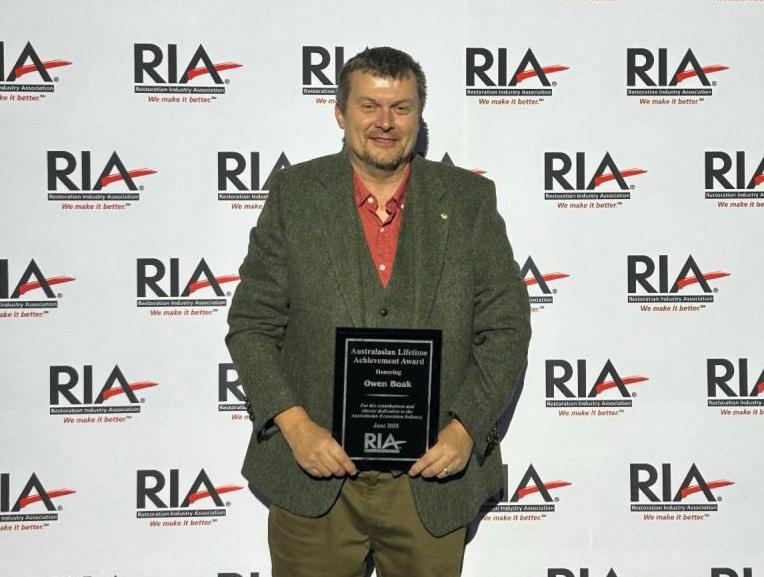

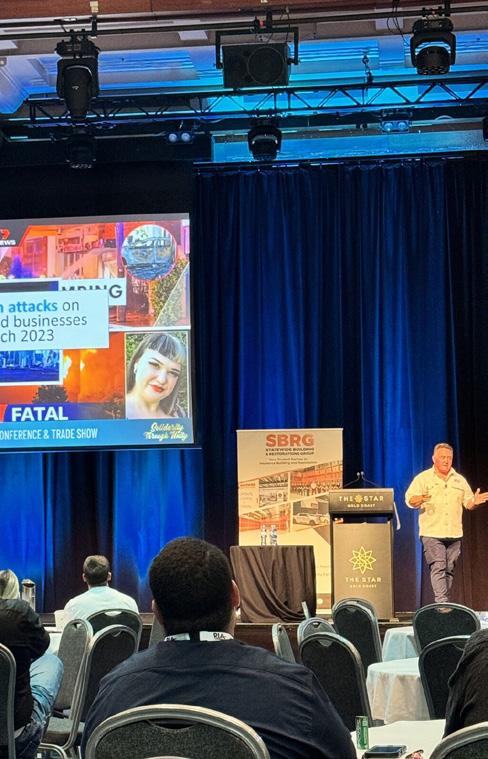
The conference wound down with an awards ceremony that saw Elements Group director Owen Boak take home the RIA Lifetime Achievement Award. Boak has been a driving force in the restoration industry for decades – a true pioneer, mentor and advocate whose legacy will be felt for generations to come. His passion, leadership and unwavering commitment to lifting standards and supporting others make him a most deserving recipient of this honour.
Another notable winner was John Hickey, the recipient of this year’s Industry Service Award. John has been a driving force in the restoration industry for decades, perpetually leading with integrity, passion and a fierce commitment to raising standards across the board. His contribution has shaped our industry for the better, and RIA was honoured to recognise his outstanding service.
The day concluded with a powerful closing address that tied together key conference themes of adaptability, collaboration and professionalism, reinforcing the importance of elevating standards across the sector.
For many, the event was more than a professional update, it was a reset. From technicians to business owners, attendees left with fresh ideas, stronger networks and a deeper commitment to the essential work of restoring not just buildings, but lives. As the crowd dispersed, the collective sentiment was clear: the future of restoration looks stronger than ever. On to the gala dinner!
With packed sessions, hands-on demos and candid discussions, the event proved why the RIA’s presence in Australasia is more vital than ever, and why the industry’s most dedicated professionals continue to show up. ■
As sustainability and ethics gain importance on the corporate agenda, environmental, social and governance (ESG) frameworks offer a structured way forward, guiding companies toward cleaner operations and stronger governance.
Words Tim McDonald
The cleaning and hygiene sector plays a critical role in public health and workplace safety, yet it’s also under growing scrutiny for its environmental and social footprint. As expectations rise around sustainability, ethics and corporate transparency, businesses across the sector are turning to ESG frameworks to navigate new standards and secure long-term viability.
Gareth Marriott, managing director of OCS, says its approach to ESG is grounded in a simple truth: “We are a people-driven business. Without people, we don’t have a business, we don’t have a service, we don’t have quality.” This principle speaks to a broader shift in how cleaning organisations are redefining value beyond cost and compliance, toward culture and responsibility.
The environmental pillar of ESG challenges cleaning companies to examine their impact on the planet. For decades, many cleaning operations relied on harsh chemicals and disposable tools. These practices are now widely seen as unsustainable. As pressure builds to reduce environmental harm, businesses must adopt alternatives that support ecological health.
Green-certified products reduce exposure to toxins and often come in recyclable packaging. Forward-thinking companies are also moving toward reusable cleaning equipment, cutting down on single-use plastics and lowering landfill contributions. Beyond products, water and energy use are key concerns. Efficient machinery, water-saving technologies and optimised scheduling can significantly reduce consumption.
“We rate ourselves tough because we never want to be accused of greenwashing or just hoping,” Marriott says. “Carbon net zero does come at a substantial cost, but we think for the good of
the business and for the good of the people, it’s a distinguishing advantage that makes a difference for the next generation.”
Waste management is another focal point. By implementing recycling protocols and reducing excess packaging, businesses can shift their environmental profile in measurable ways. In an industry where volume and repetition are central, even small adjustments can compound to have a significant impact.
“When we started this journey, we had little idea how, when or what it would look like,” Marriott says. “My advice is to talk to someone who knows what they’re doing and start with what matters to your business.”
The social element of ESG is the most visible and immediate.
Cleaning work is essential but often undervalued, and many employees in the sector face precarious conditions with limited benefits. ESG calls for a shift in how these roles are supported, protected and recognised.
“Customers today are looking for more than just the norm and the person with a mop and a bucket,” Marriott observes. “They’re looking for value and community engagement.” That shift demands a new approach to workforce support, one built on fair wages, safe conditions and everyday acts of appreciation.
“Recognition is becoming less and less,” he adds. “It’s not about social media. It’s about leaving a note, saying thanks, or even giving someone a lolly. We’re not doing enough of that.”
Providing fair wages is fundamental to ensuring staff have access to leave entitlements and superannuation contributions in line with legal and ethical standards. Safety is equally vital. Cleaning in healthcare, industrial or large commercial sites involves real physical risk. Employers must maintain high safety protocols, offer proper training and supply reliable PPE.

Marriott says the industry's job is to make it as easy and less complicated as possible for our team members. “Our unsung heroes are those who go out every single night while the rest of us are sleeping,” he says. That frontline focus is driving a new kind of social investment, one that values people as the foundation of service quality.
Strong governance ensures ESG commitments are not just symbolic. It involves setting clear policies, disclosing performance, and holding leaders accountable for results. In cleaning businesses, governance provides the structure needed to deliver on environmental and social goals.
“Governance is more than just a checklist,” Marriott explains. “It’s about having a strategic plan with clear objectives and vision, and aligning operational delivery with that bigger picture.” That alignment starts with leadership and filters through every level of the organisation.
OCS backs its governance with action. “We’ve done more than a thousand executive site visits this year,” Marriott notes. “If we don’t leave our offices and go to the frontline, the governance falls over.” Site visits, audits and open communication reinforce ethical standards and keep the business grounded in its operational reality.
Transparency is also critical. This means sharing sustainability data, publishing progress reports and being open about supply chains and sourcing. Accountability mechanisms such as feedback loops and grievance procedures ensure that clients and staff have confidence in the company’s integrity.
In its latest Australia and New Zealand ESG Report, OCS outlines a clear plan to achieve net zero greenhouse gas emissions across its operations in the region by 2040, aligning with the wider OCS Group strategy.
This target is underpinned by science-based milestones, Toitū Envirocare Net Carbon Zero certification and independent audits, reflecting OCS’s commitment to environmental stewardship on both a regional and global scale.
The report details initiatives that span every part of the business, Fleet transition plans have seen 16 percent of vehicles across Australia and New Zealand transition to electric or hybrid, waste-to-landfill emissions reduced by almost 25 percent compared to the baseline, and all New Zealand offices are now powered by 100 percent renewable energy through Ecotricity. Supplier partnerships are also driving change, with enhanced due diligence processes and product reviews aimed at helping reduce Scope 3 emissions.
Across Australia and New Zealand, these environmental actions are complemented by strong social contributions, including creating employment pathways for people with disabilities and partnerships with organisations such as the First Foundation and Wheelchairs for Kids. OCS’s Australia and New Zealand ESG Report provides stakeholders a transparent view of how these commitments are being delivered locally while contributing to a global goal of making people and places the best they can be.
Adopting ESG principles is no longer a niche pursuit in the cleaning industry. It is fast becoming a baseline for business legitimacy. Regulatory expectations are rising, particularly in environmental reporting. Clients are demanding greener solutions and fairer labour practices. Investors are screening for ethical performance, not just profitability.
“We’re not just a cleaning company,” Marriott says. “We’re not just a facilities management company. We’re a people-driven business with the right culture and values at our core.”
For cleaning companies, ESG offers both a challenge and an opportunity. By embedding it across operations, businesses can reduce waste, attract talent and protect their reputation. It opens the door to contracts with organisations that prioritise sustainability. It also insulates the business against legal and reputational risks.
In a world that demands cleaner outcomes in every sense, ESG gives the cleaning industry a powerful lens to drive improvement. It is no longer just about spotless surfaces, it is about responsible leadership and lasting impact. ■ Download the full OCS ESG here: ocs.com/nz/2024-esg-report/
Dermalux® Cleansing Wipes are perfect for everyday patient care in aged care, beauty, and dental care. They’re gentle on skin and contain soothing aloe vera, leaving skin feeling fresh and invigorated. They are a single-use wipe designed for everyday use. One wipe should be used for each patient area, such as face, hands, back and perineal area.
` Dermatologically tested
` 100 percent biodegradable bamboo cloth
` Gentle on the skin, and effective for cleaning and moisturising
` pH balanced, alcohol and paraben free
Whiteley
1800 833 566
sales@whiteley.com.au whiteley.com.au


Sabco Professional has unveiled its top-tier flat mop pad, the Decitex Ultimate 3D – a smart, sustainable solution for high-performance cleaning. Crafted entirely from recycled polyester yarns and materials, this mop pad is designed for serious results without compromising the planet.
Engineered with 80 percent knitted microfibre, it delivers powerful cleaning action with minimal micro-particle loss, making it as gentle on the environment as it is tough on grime. Independent testing to the EN16615 standard has shown it achieves an impressive 99.9993 percent reduction in bacteria – a -5.13 log reduction – raising the bar for hygienic performance.
Its lightweight construction means less strain on staff and significantly reduced water and chemical use across repeated applications. Supplied in a convenient 25-pack, the Decitex Ultimate 3D Flat Mop Pad is proof that exceptional cleaning and environmental responsibility can go hand in hand.
Sabco Professional sabcoprofessional.com.au

RapidClean’s latest mop head range is setting a new benchmark in commercial cleaning, combining absorbency, durability and ease of use across every surface. Engineered for highperformance results, each mop in the range has been tailored to meet the daily demands of professional cleaning teams.
The Entice Mop Head (400g) offers exceptional absorbency and a smooth glide, cutting through grease with ease. The Contractor Mop Head (400g) delivers dependable everyday cleaning with a robust cotton blend construction. For longer-lasting use, the Premium Mop Head (400g) features virgin cotton and heat-seal technology that stops fraying before it starts. And when only the best will do, the Premium Microfibre Mop leads the pack with superior dirt pick-up and an effortlessly smooth motion.
From fast-paced facilities to deep-clean environments, RapidClean’s mop head range is built to keep up.
Explore the full range at rapidclean.com.au or visit your local RapidClean Member.
RapidClean sales@rapidclean.com.au
rapidclean.com.au

Nimble and intelligent, the X4 ROVR Robotic Scrubber is purpose-built with productivity in mind. With advanced sensors, smart navigation and realtime adaptability, it effortlessly manoeuvres around tight obstacles while delivering consistent, high-performance scrubbing. Designed for smarter cleaning, it boosts efficiency without compromising on coverage or safety. Tennant Australia tennantco.com.au

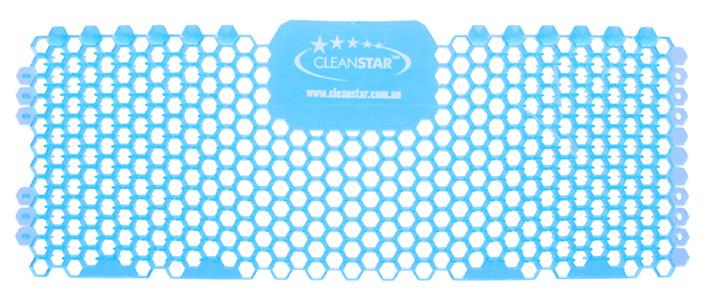
Cleanstar’s new range of trough urinal screens are designed for high traffic areas and large venues to ensure complete coverage of the urinal. Available in Lemon and Ocean Mist fragrances, they are ideal for use in male trough urinals in schools, universities, clubs, pubs, restaurants, offices, shopping centres and hotels. Available as a 10-pack. Sample packs are also available.
CLEANSTAR (03) 9460 5655
sales@cleanstar.com.au
cleanstar.com.au

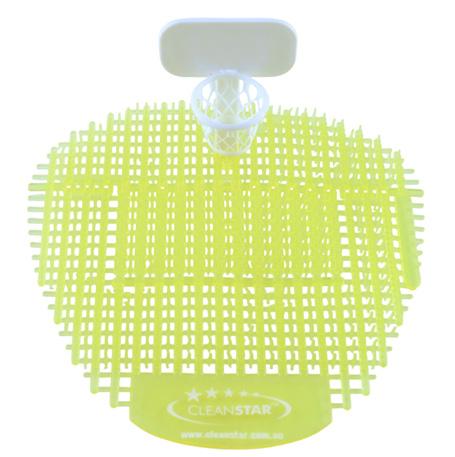
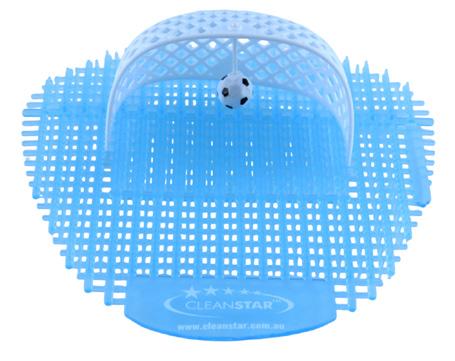
If you’re a soccer (“football”) or basketball fanatic, you’ll love Cleanstar’s interactive sportingthemed urinal screens that add entertainment to the toilet.
Available in Lemon and Ocean Mist fragrances, these urinal screens provide opportunities for facility operators such as pubs, sporting clubs, schools and more to enhance user experience and product engagement in male restrooms. Available as a 10-pack. Sample packs are also available.
CLEANSTAR (03) 9460 5655
sales@cleanstar.com.au
cleanstar.com.au

Clinging where it counts, Sequal is a thickened, mildly acidic cleaner that delivers a deeper, longer-lasting clean. Designed to adhere to vertical surfaces, it stays in place to break down scale, rust and stubborn stains across toilets, urinals, tiled floors, basins and showers – all without harming stainless steel.
Its powerful formula makes it an ideal choice for daily use in high-traffic washrooms, offering the kind of targeted cleaning professionals can rely on. Certified by GECA and free from phosphates, Sequal pairs performance with environmental responsibility, proving that a strong clean doesn’t need a harsh footprint.
Agar Cleaning Systems
1800 301 302
sales@agar.com.au agar.com.au/sequal
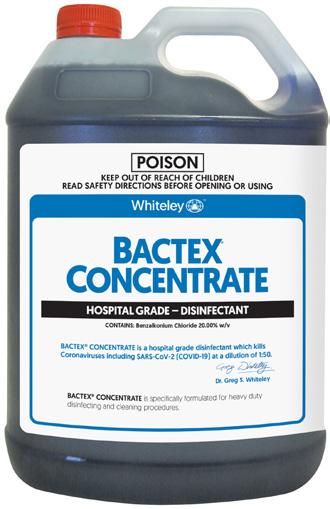

Bactex® Concentrate is a concentrated quaternary-based, pH-neutral hospitalgrade disinfectant that kills Coronaviruses, including SARS-CoV-2 (COVID-19) at a dilution of 1:50. It has excellent cleaning and deodorising properties and can be used as a general-purpose cleaner and disinfectant for environmental surfaces. The concentrated surfactant system in Bactex® Concentrate makes it an excellent hard surface cleaner. ` Dual-purpose cleaner and disinfectant ` Mild yet effective surfactant system supports rapid disinfection Whiteley 1800 833 566 sales@whiteley.com.au whiteley.com.au
Lemex
Lemex is a neutral detergent containing a powerful cationic surfactant and a fresh, long-lasting lemon perfume. Being neutral, it is noncorrosive to fibres and common hard surfaces, including normal domestic, commercial and most hospital/medical flooring. Lemex is suitable for surface cleaning and use on other Class 1 Medical Devices. Using Lemex as directed ensures healthcare facilities comply with current healthcare regulations.
` Versatile, general-purpose cleaner
` pH neutral – excellent materials compatibility
` Non-corrosive
Whiteley
1800 833 566
sales@whiteley.com.au whiteley.com.au
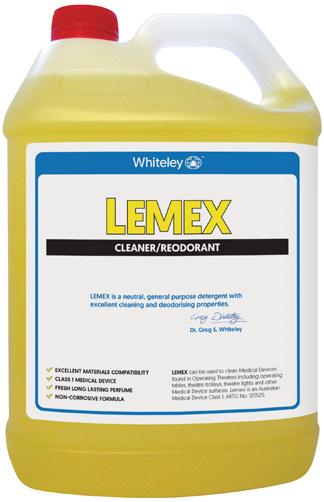

Wildflower by AGAR is a commercial-grade disinfectant that goes beyond cleaning – it elevates an entire space. With its high-foaming formula and elegant floral fragrance, Wildflower tackles grime and odour-causing bacteria in one easy step, leaving behind a space that feels as fresh as it looks.
Designed for versatility, it’s suitable for use on all washable hard surfaces, from tiled bathrooms to walls and floors. Whether used as a surface cleaner or a fragrant air freshener, Wildflower delivers powerful hygiene with a polished finish – making it a favourite for facilities that value both cleanliness and ambience.
Agar Cleaning Systems
1800 301 302
sales@agar.com.au agar.com.au/wildflower


